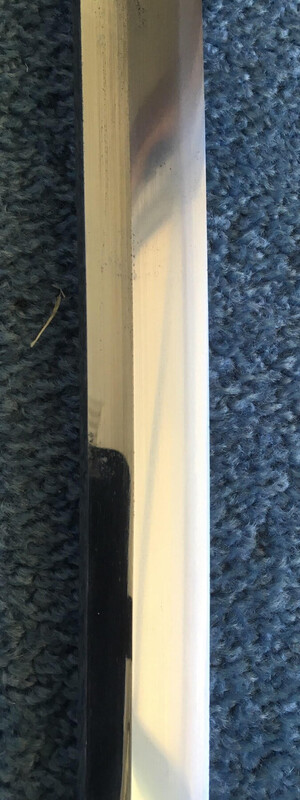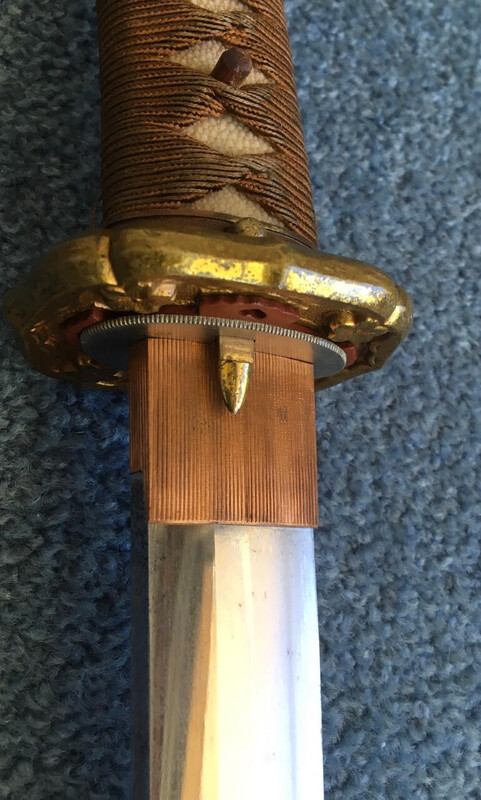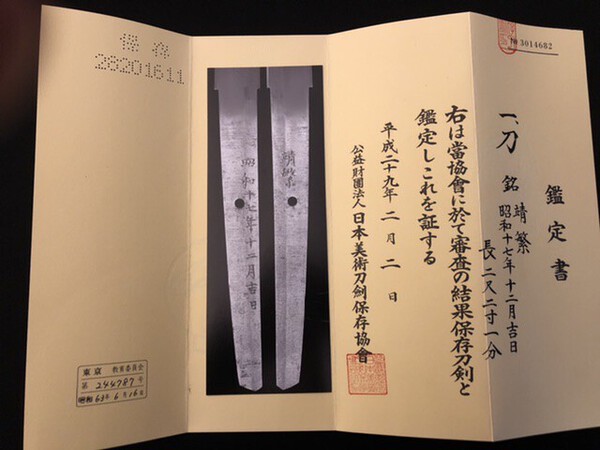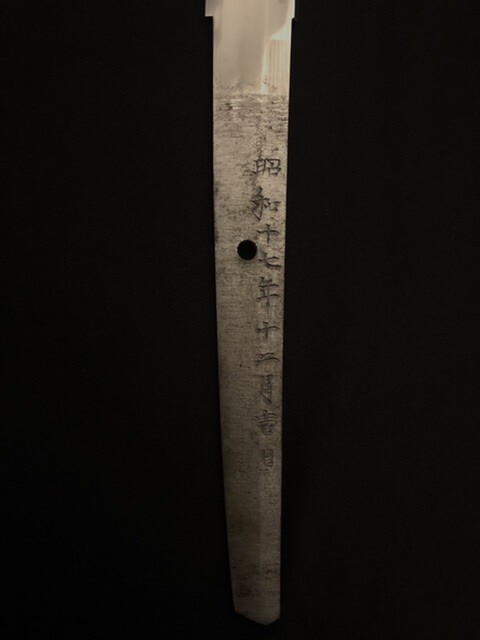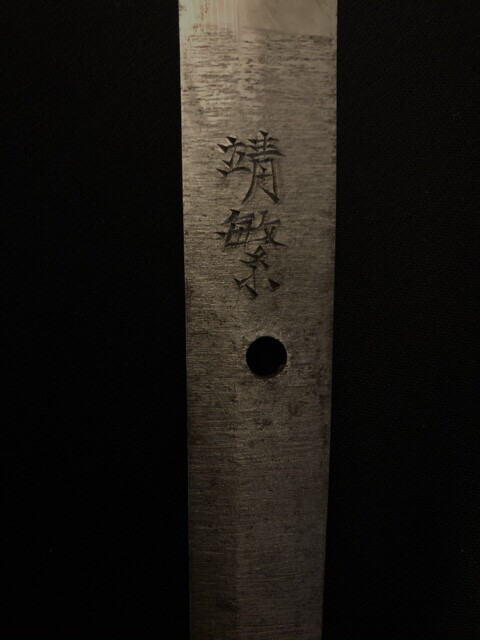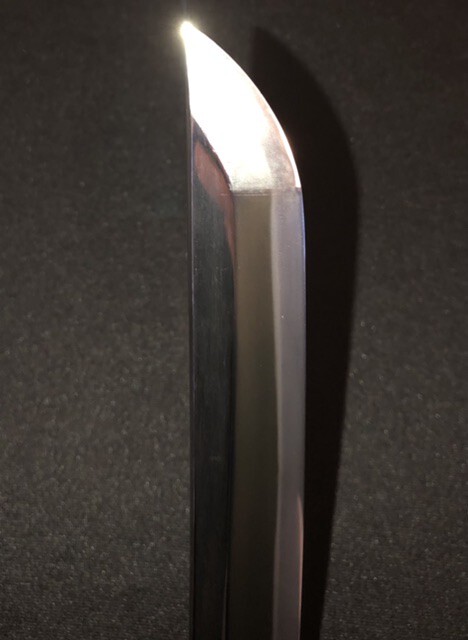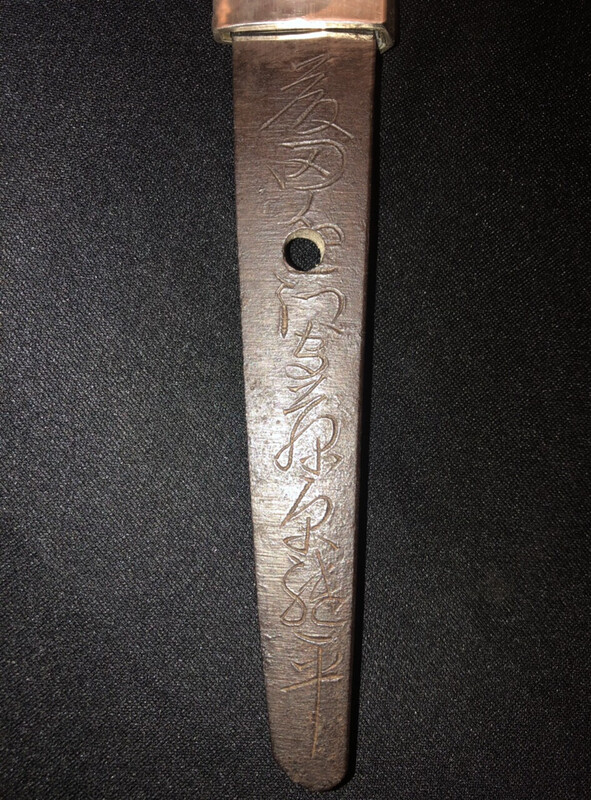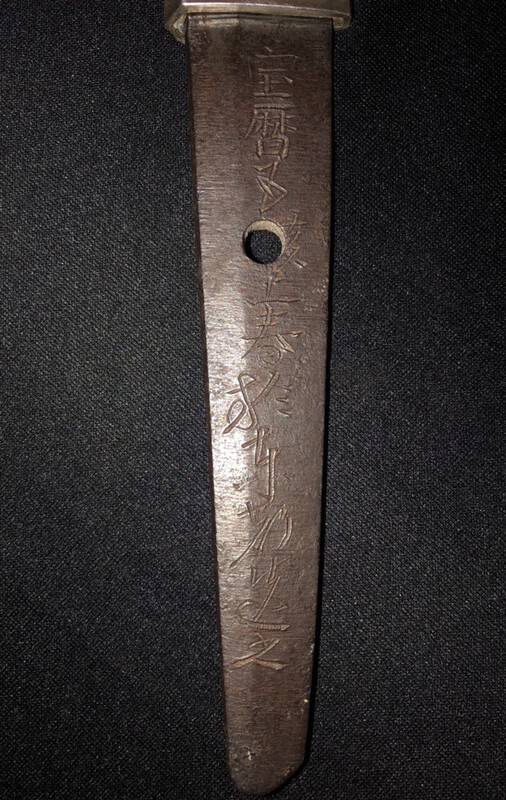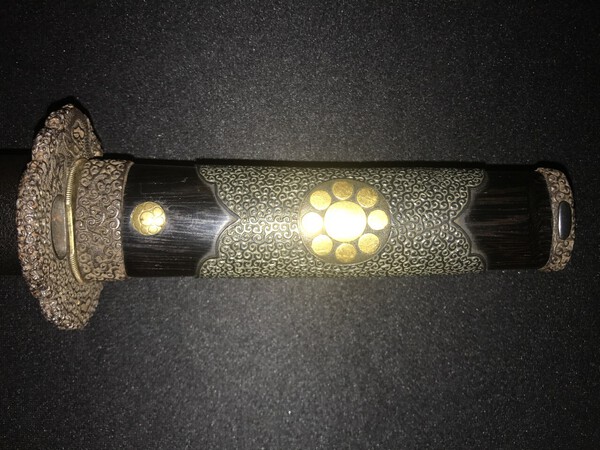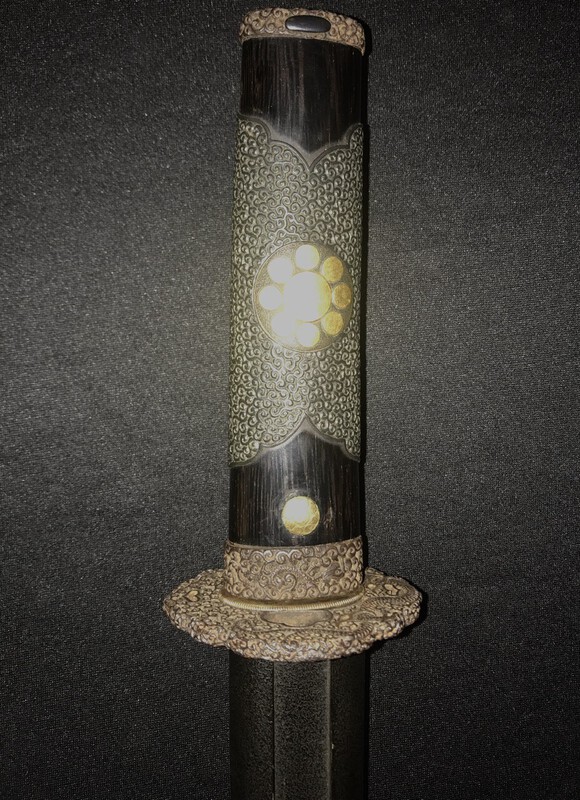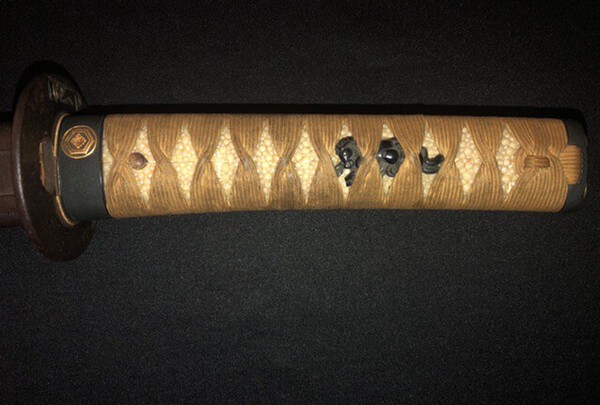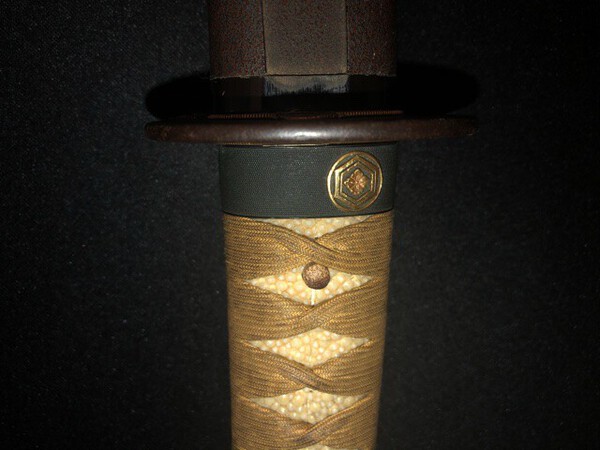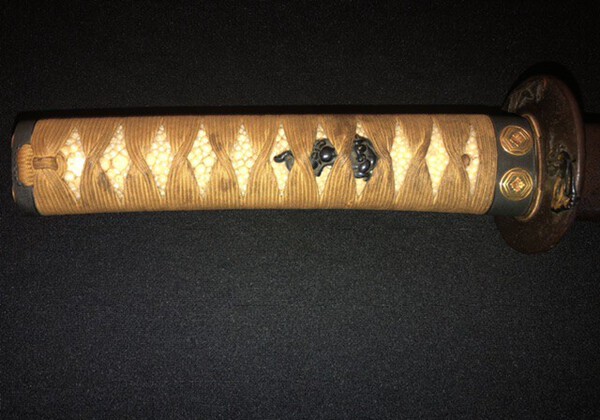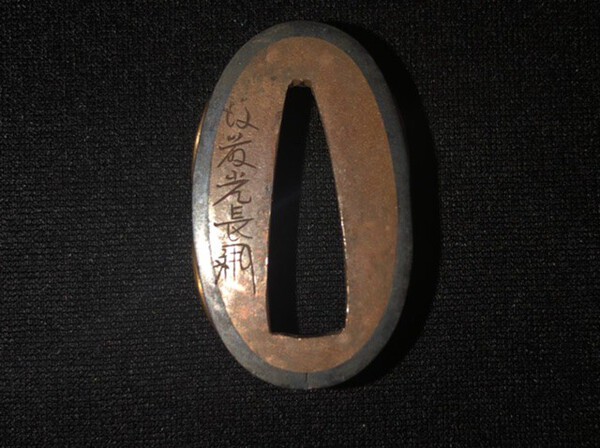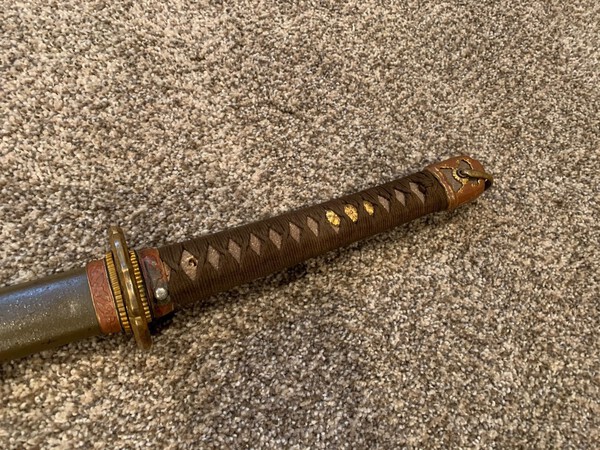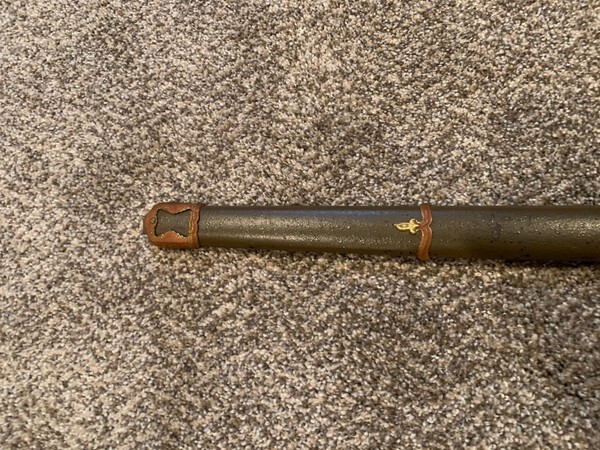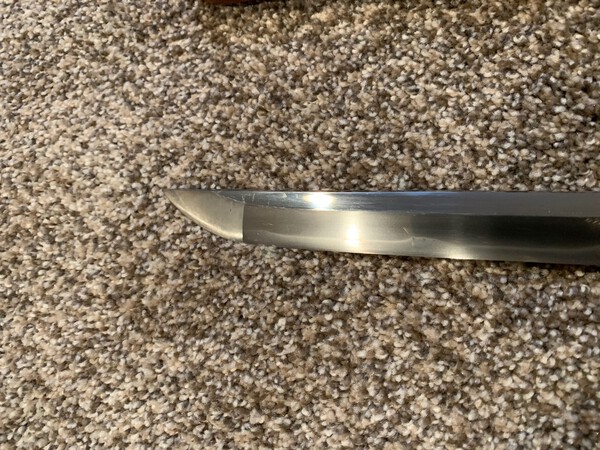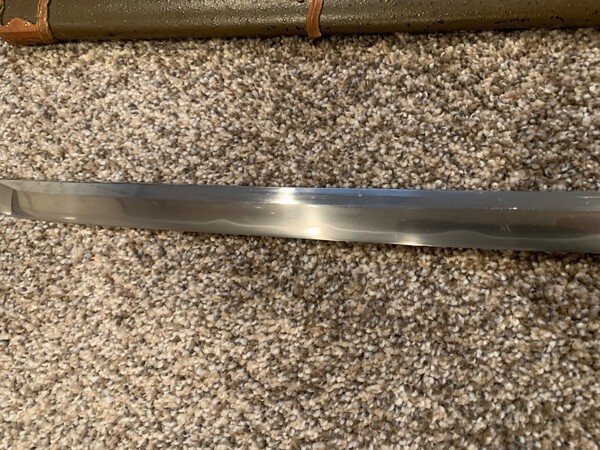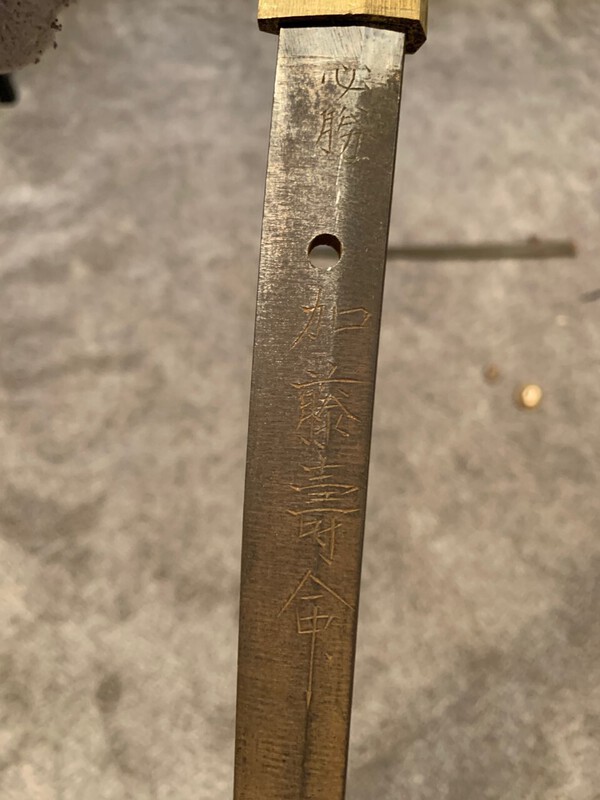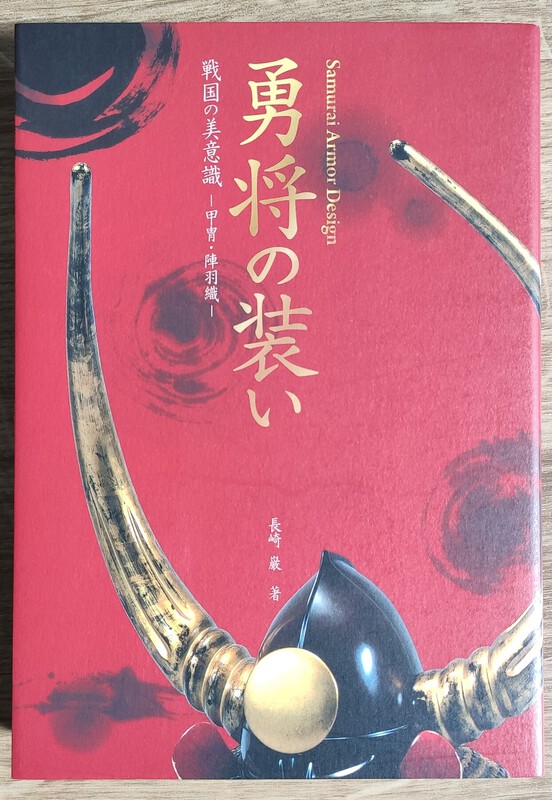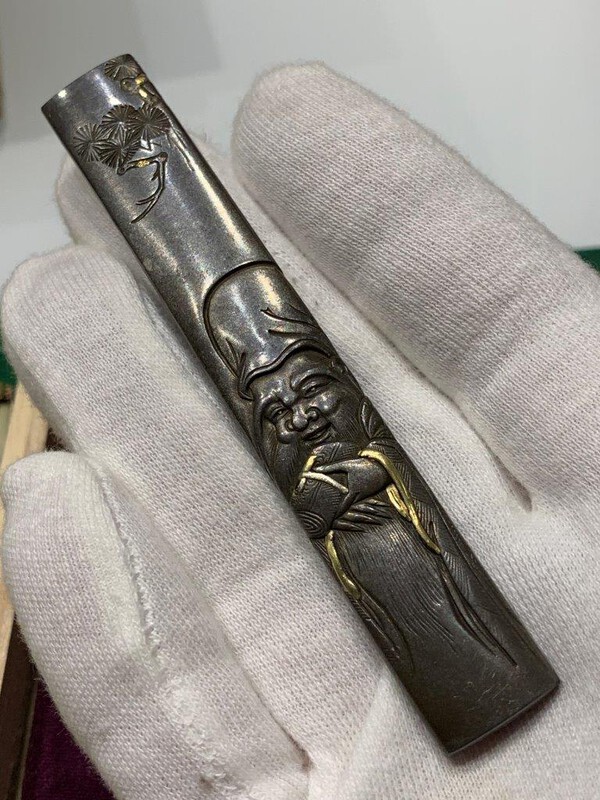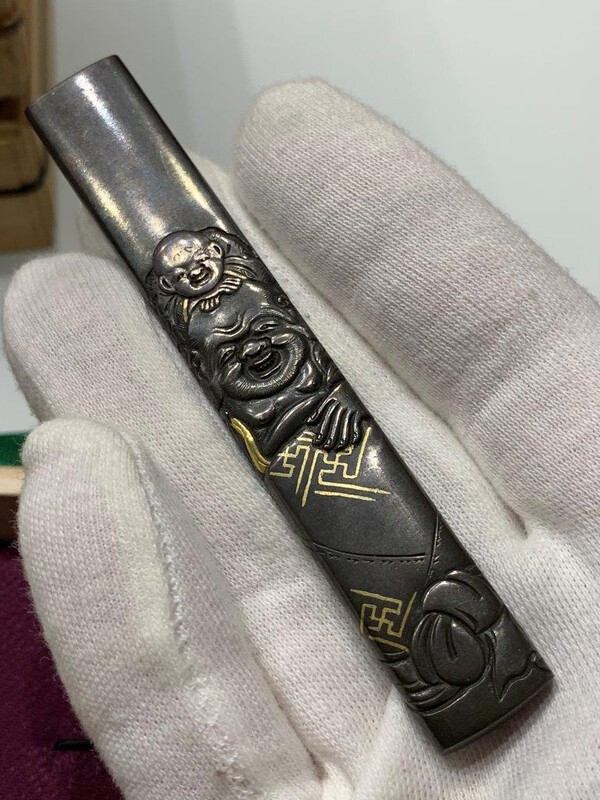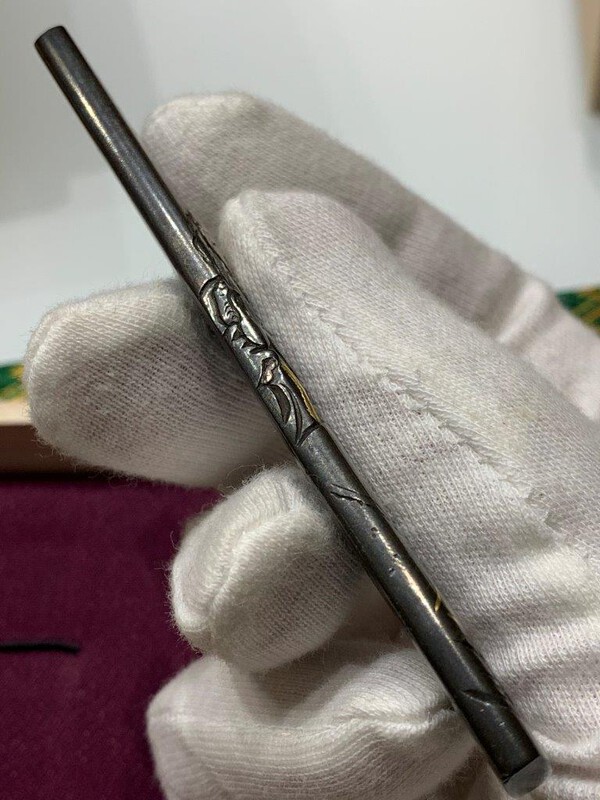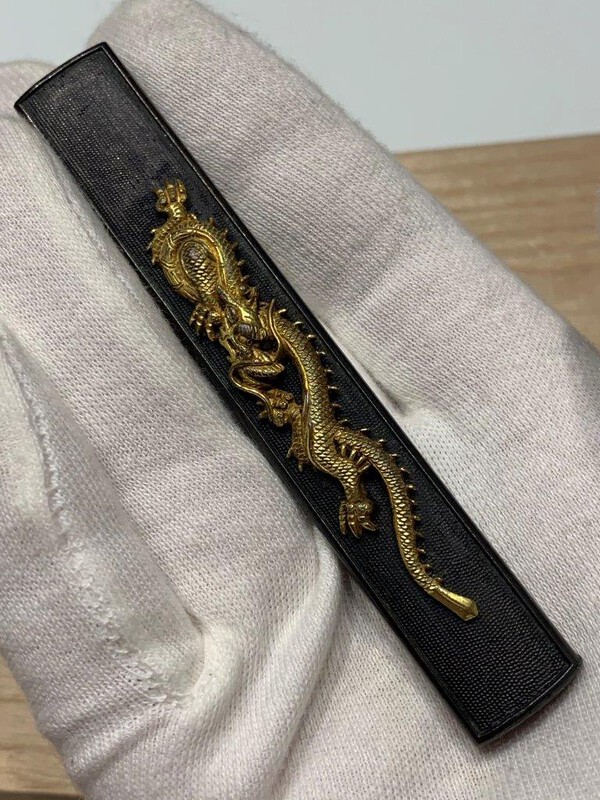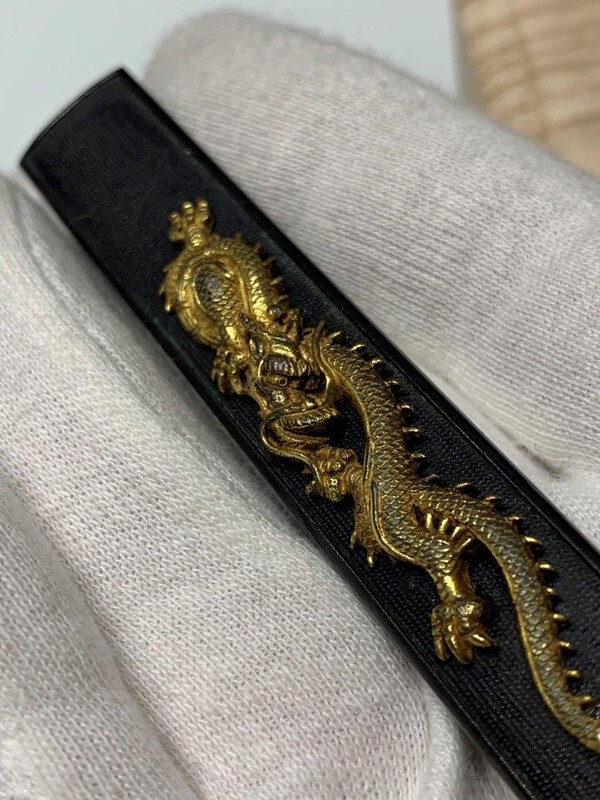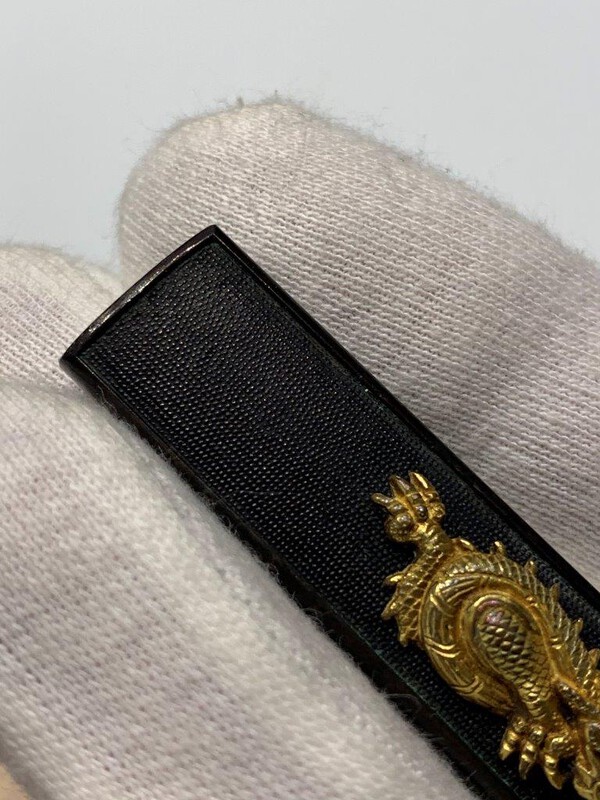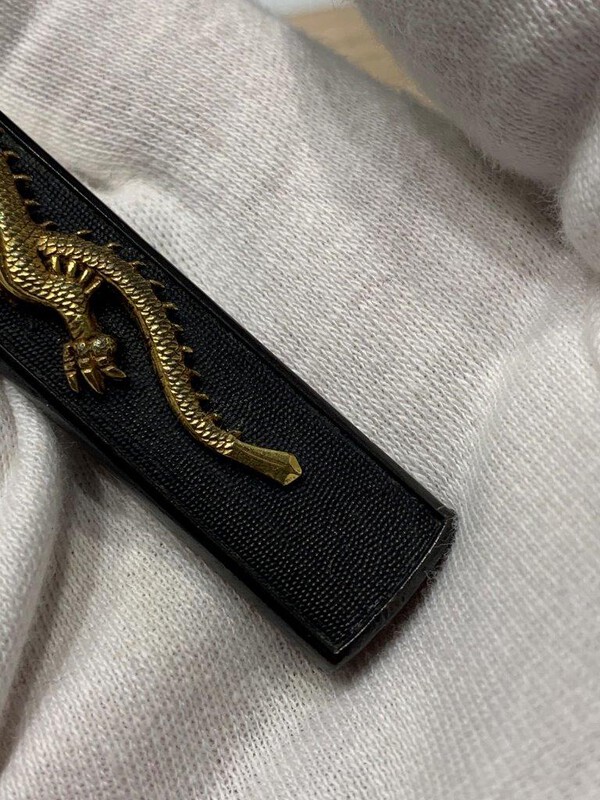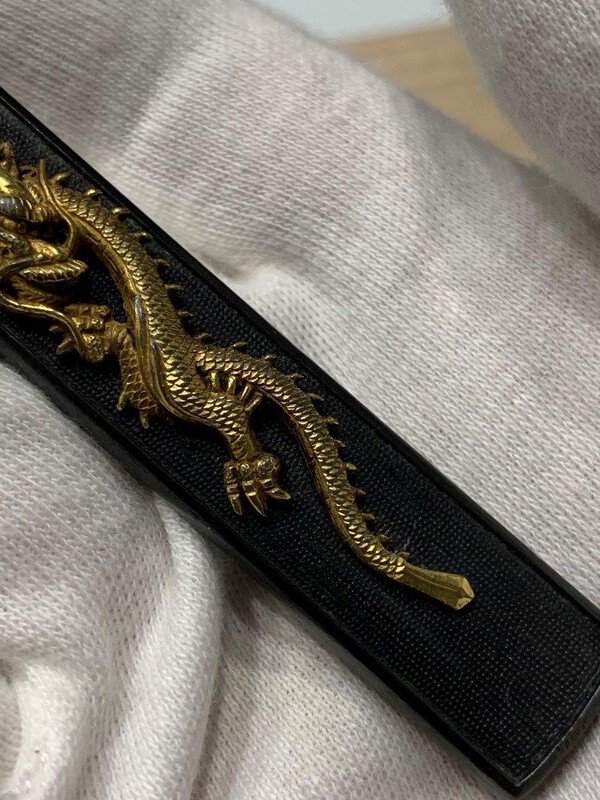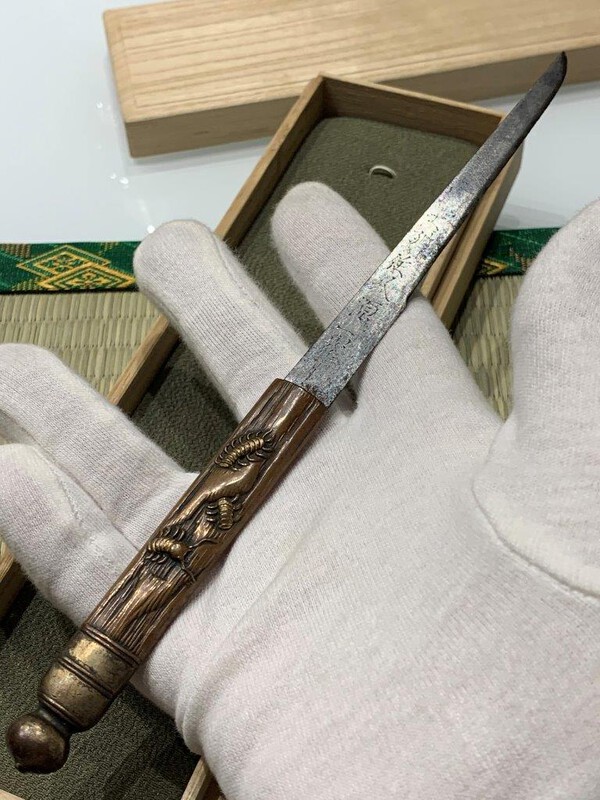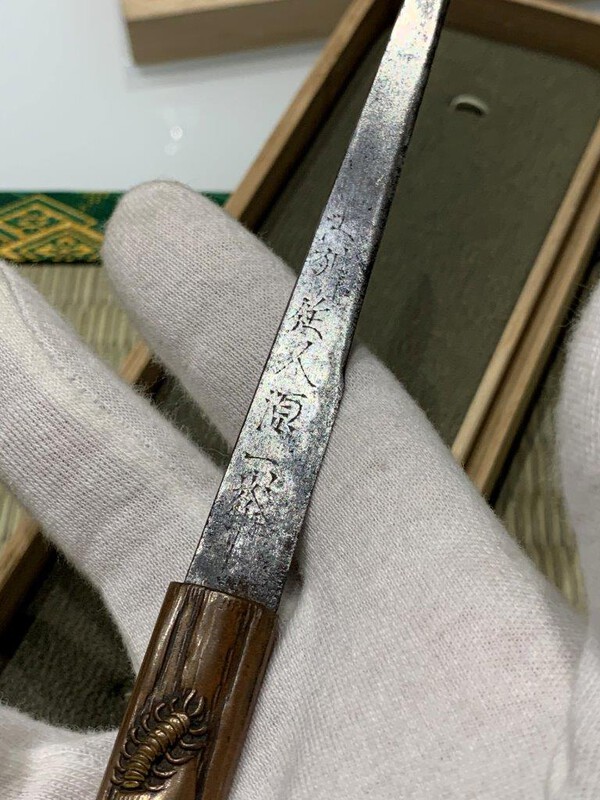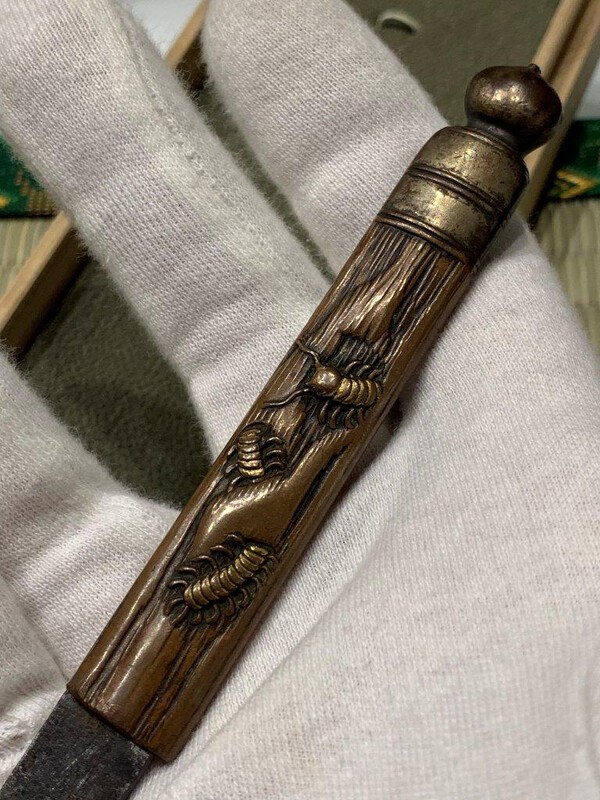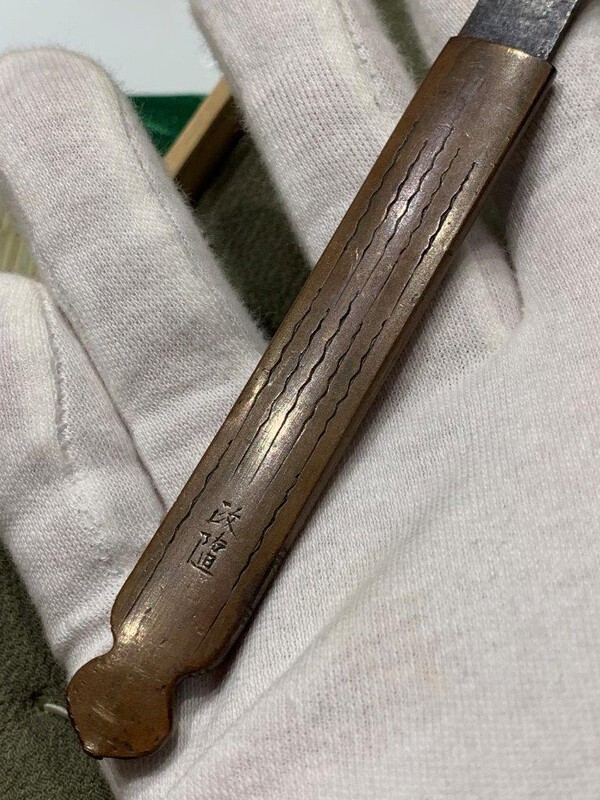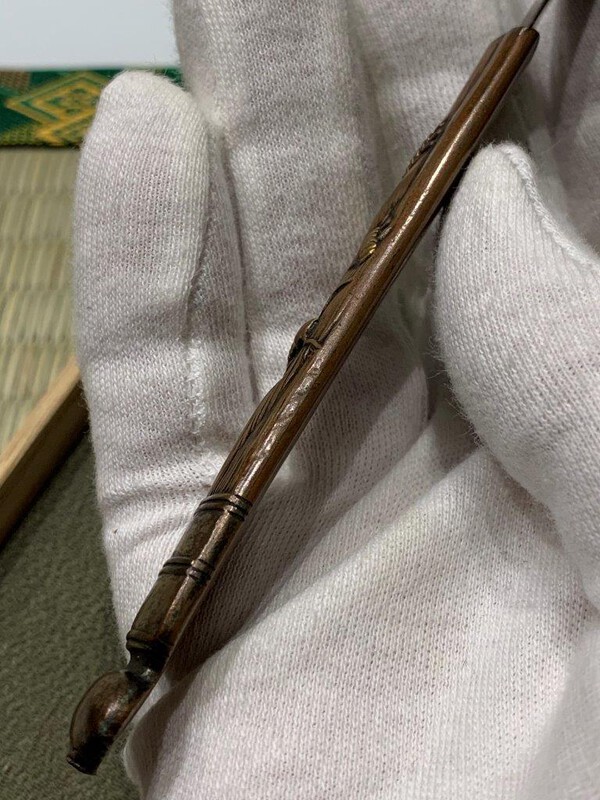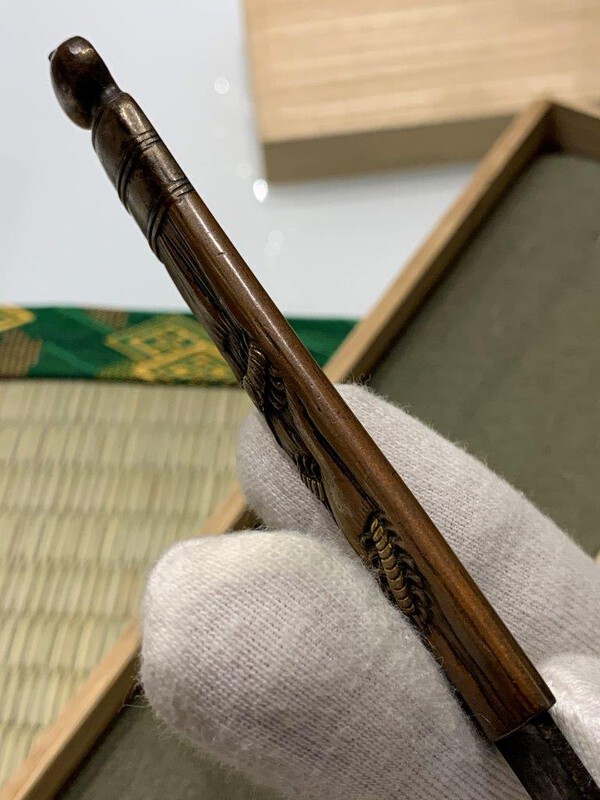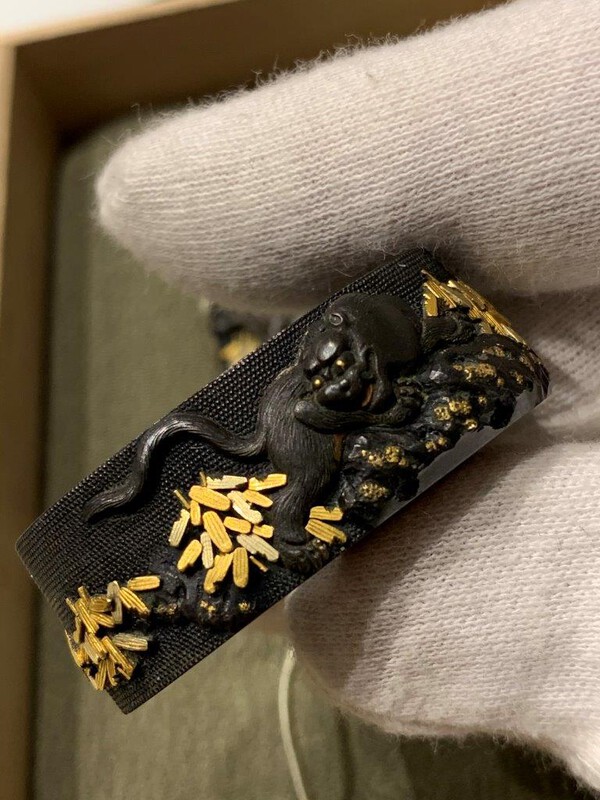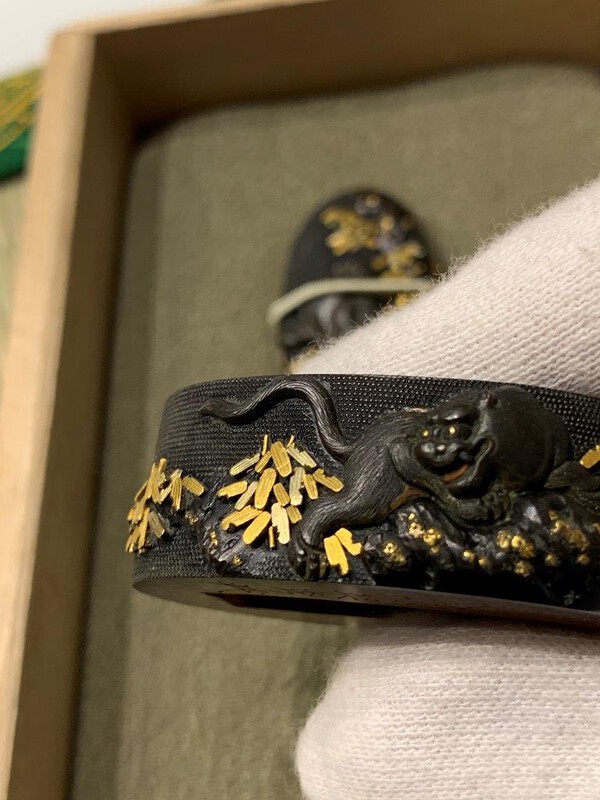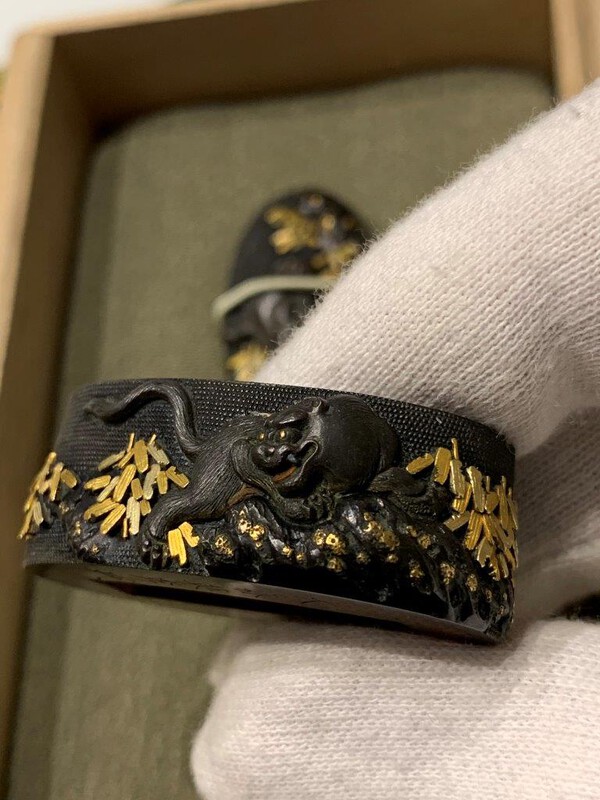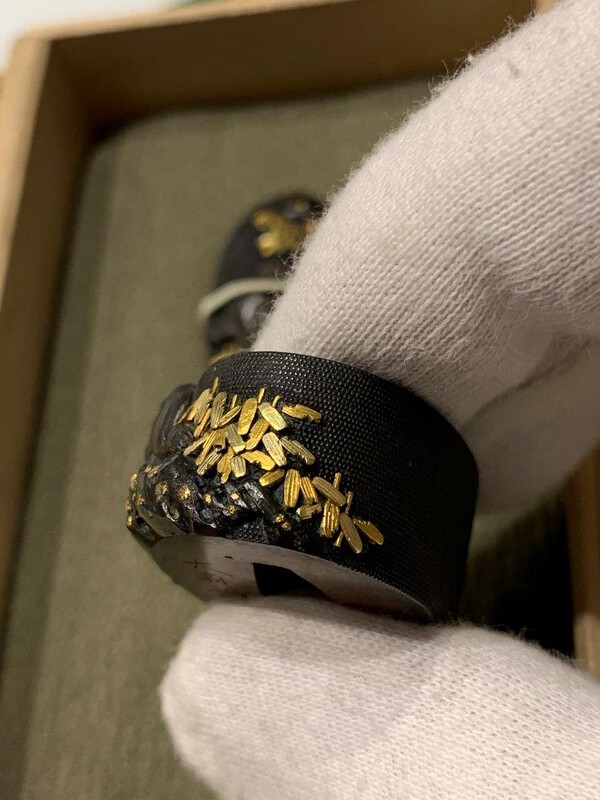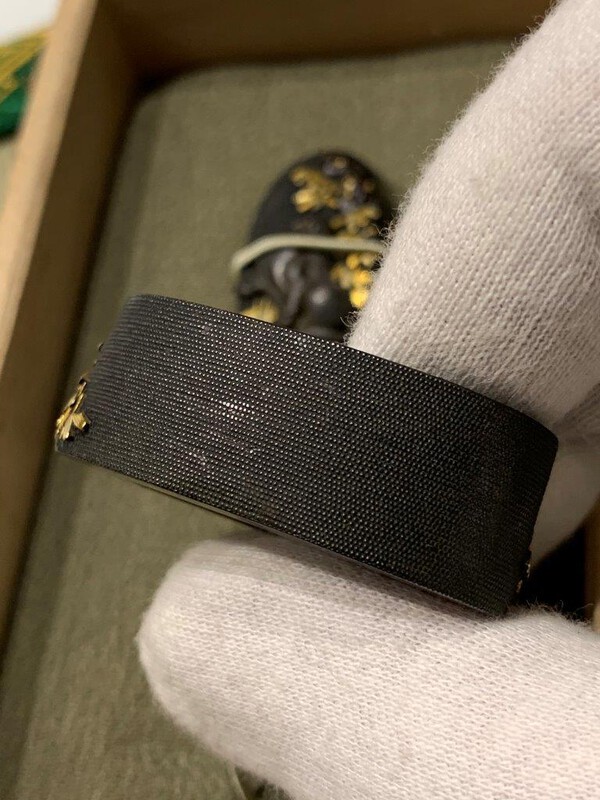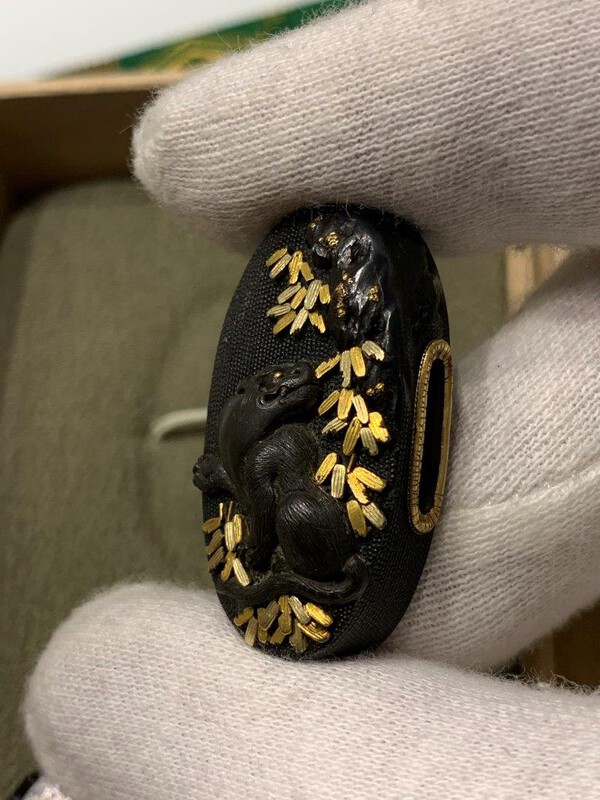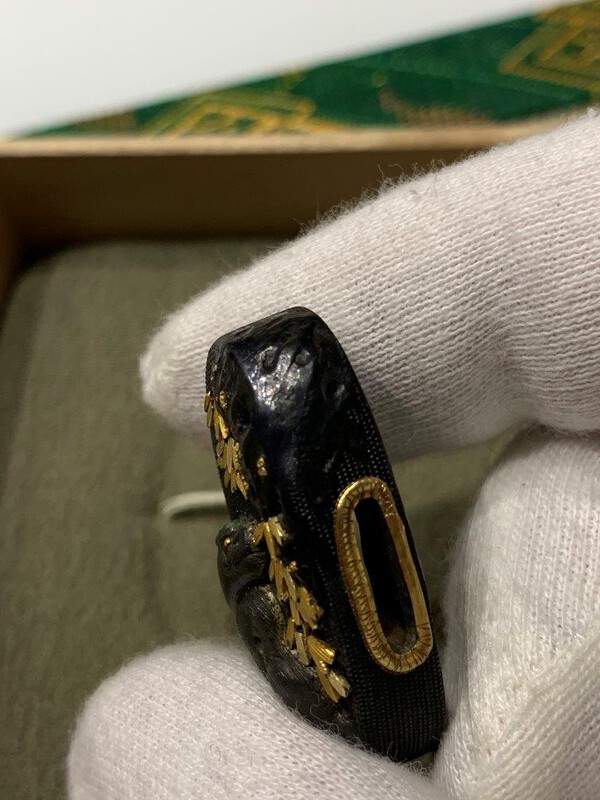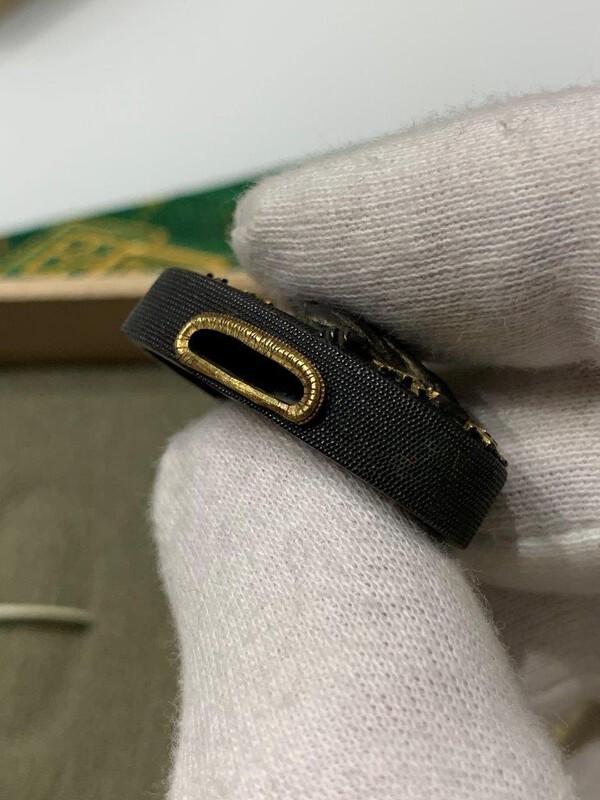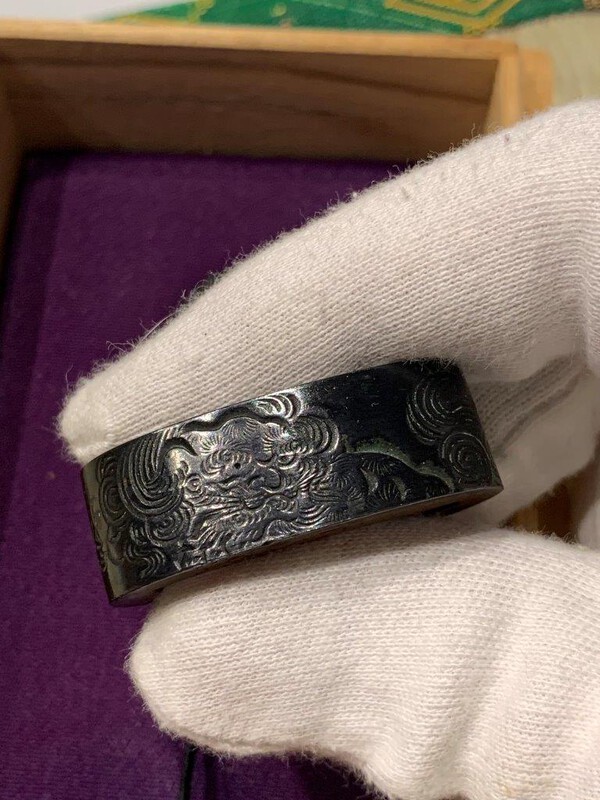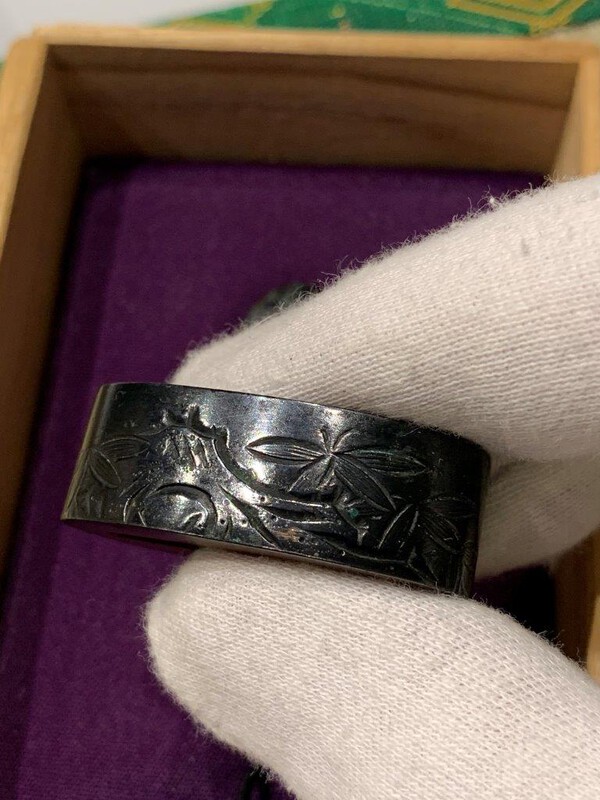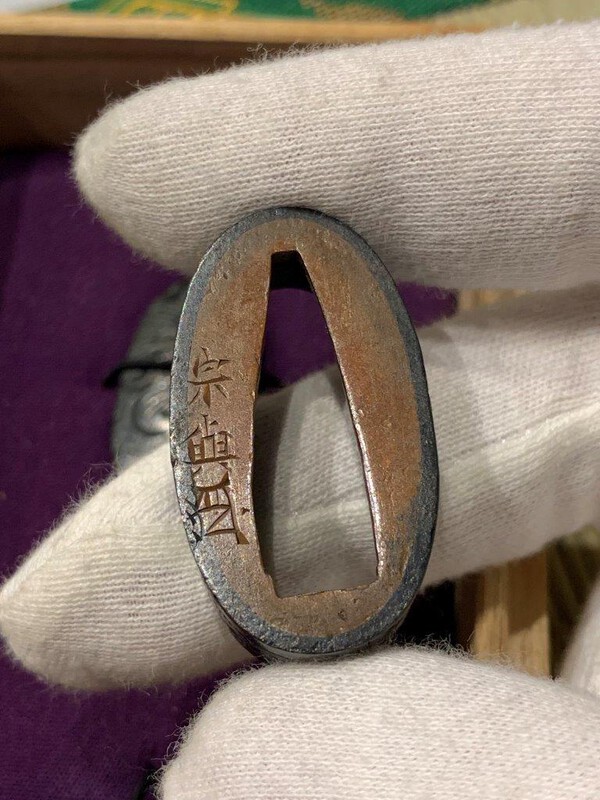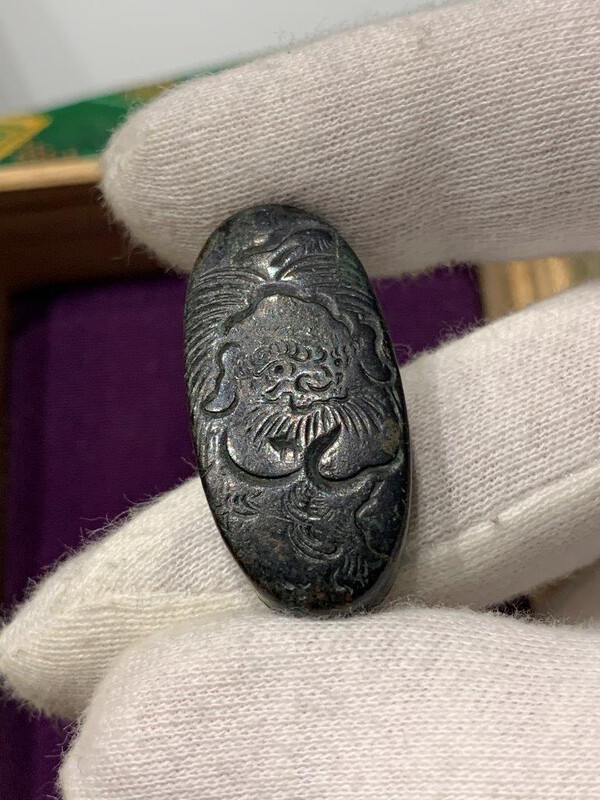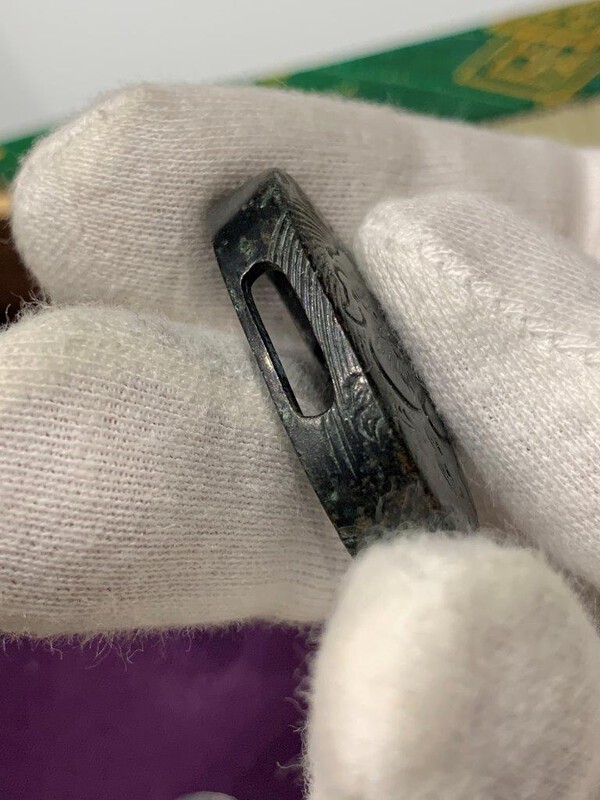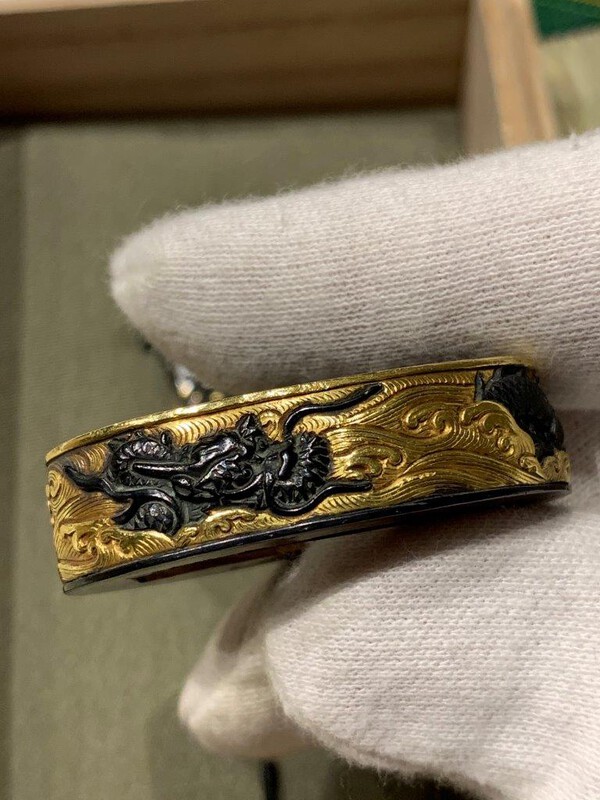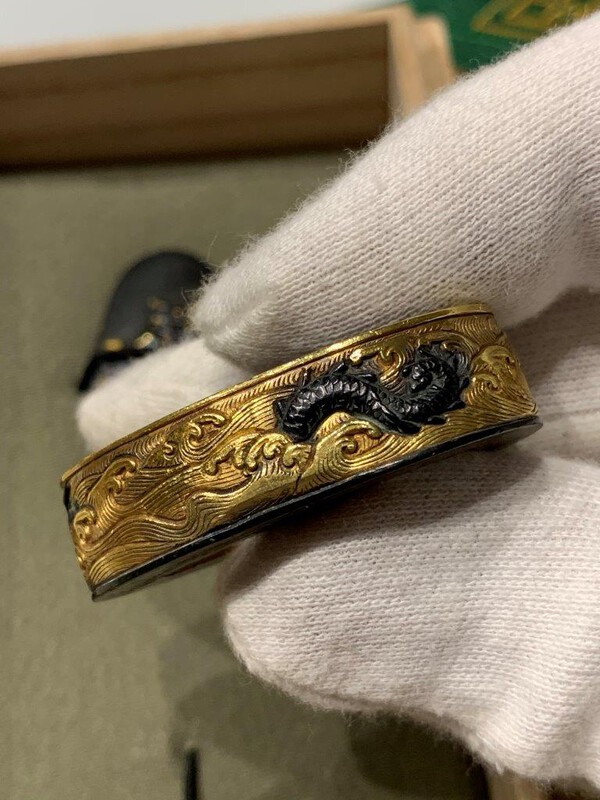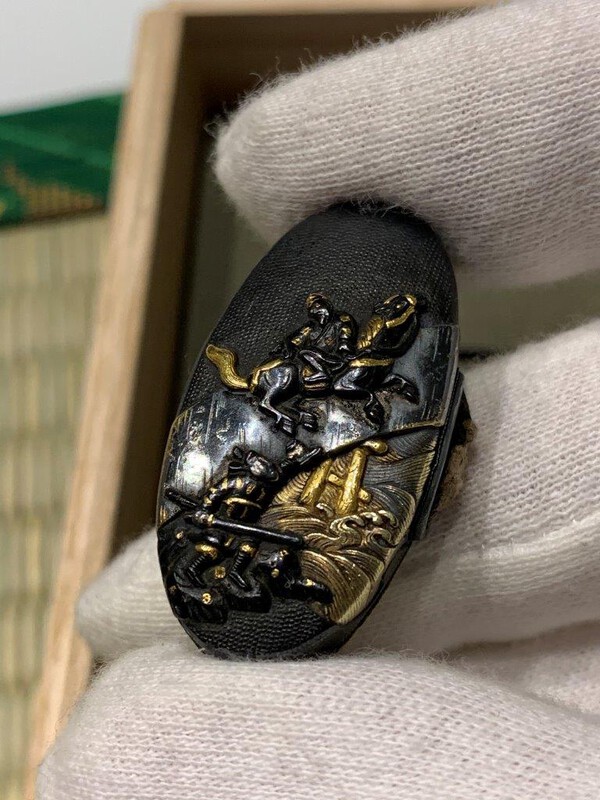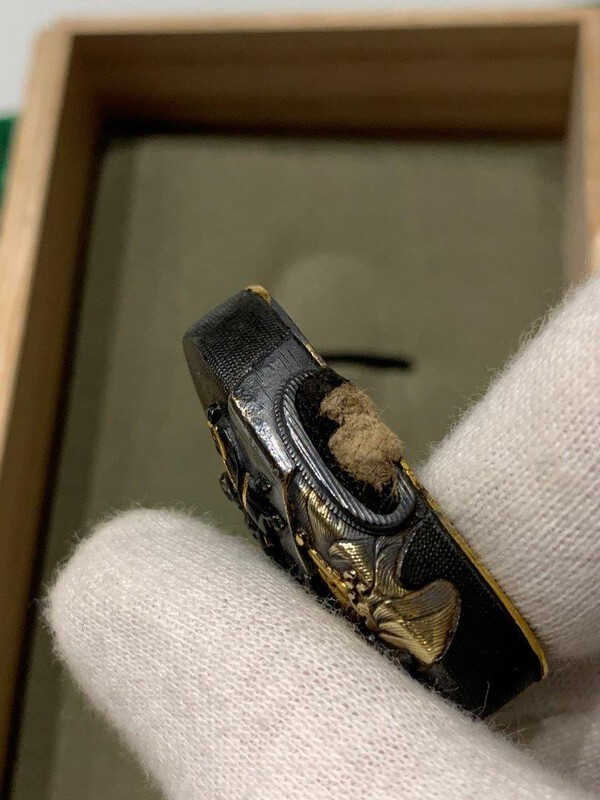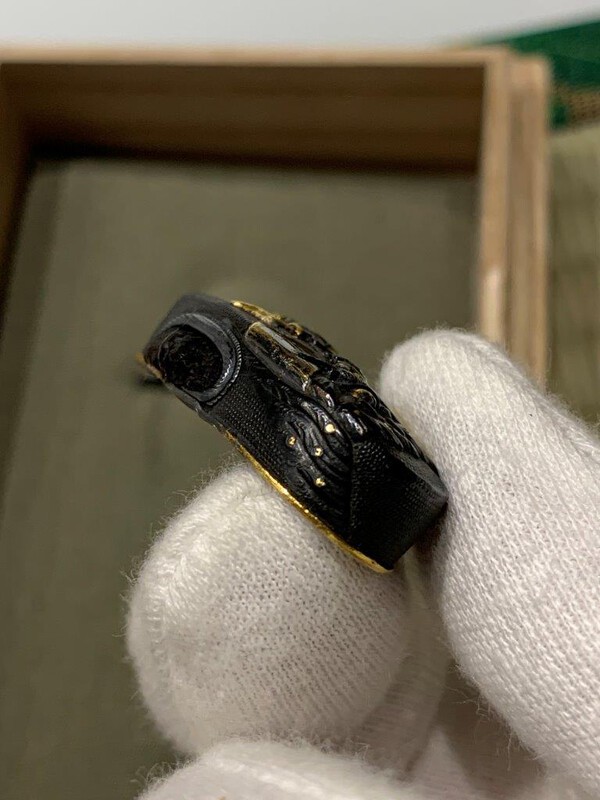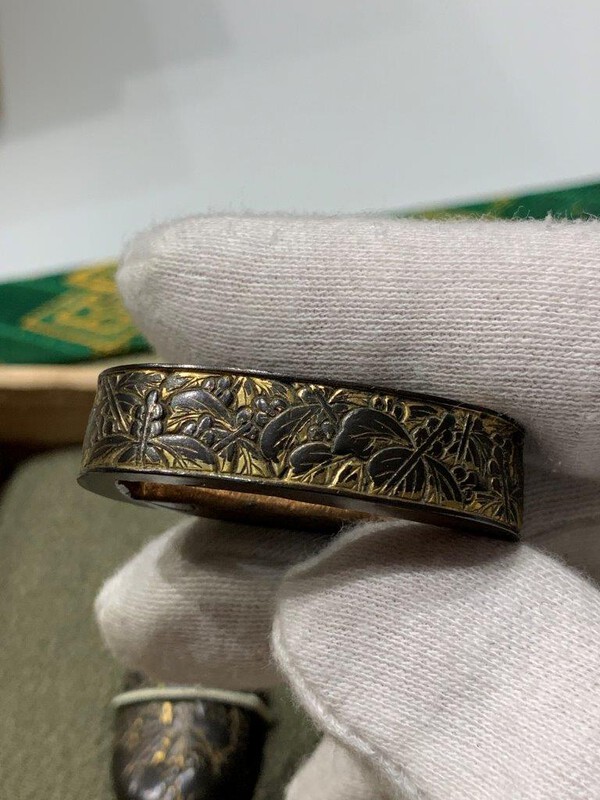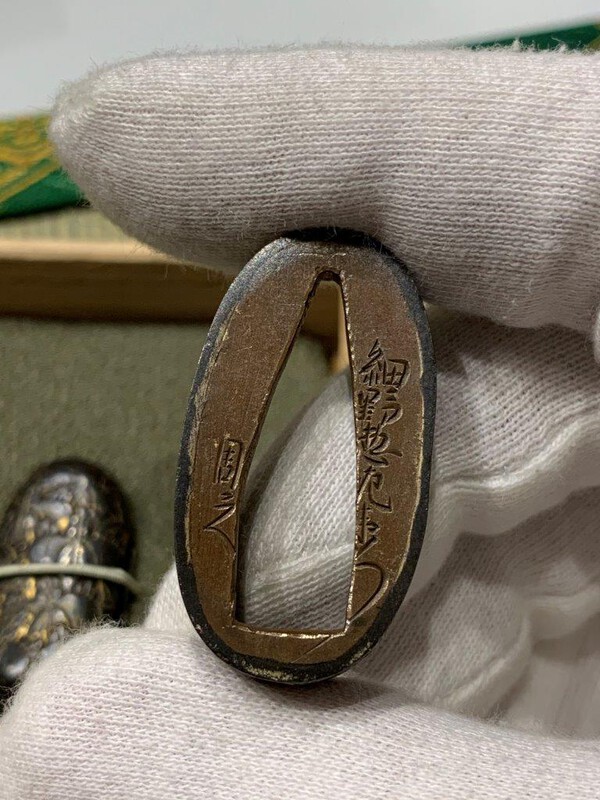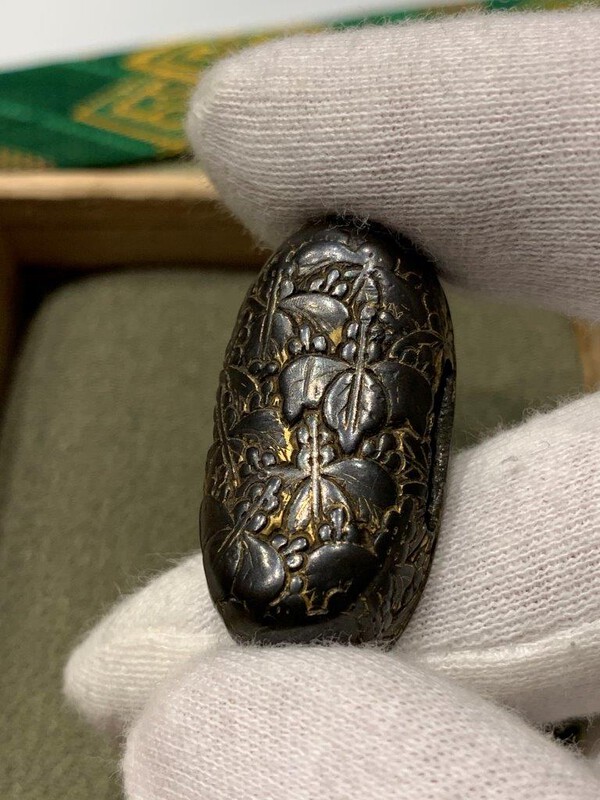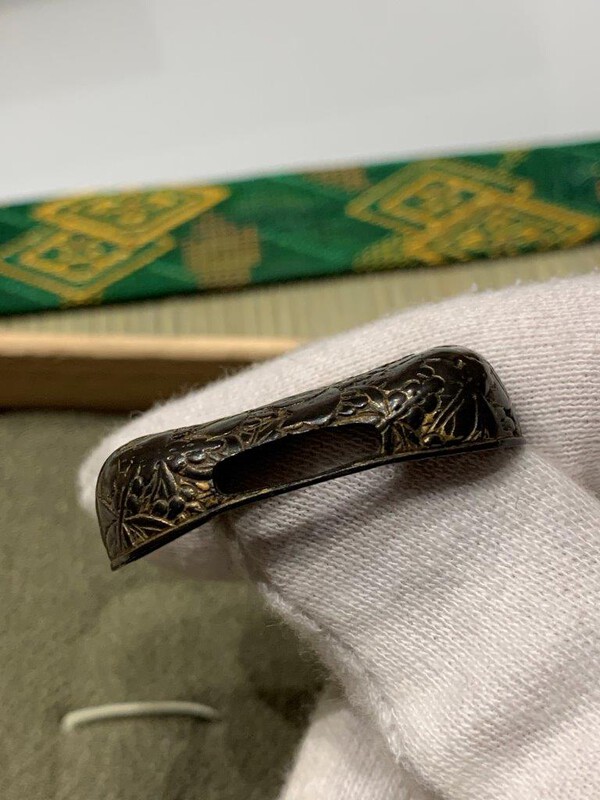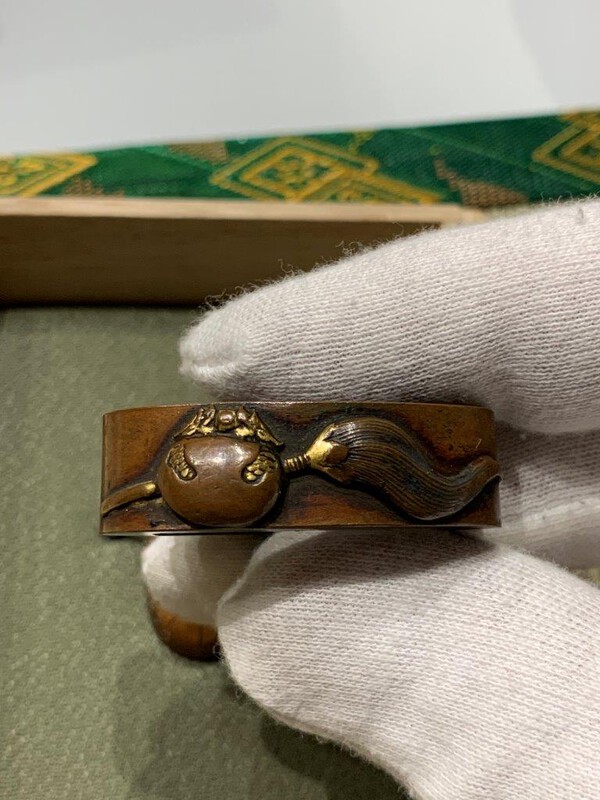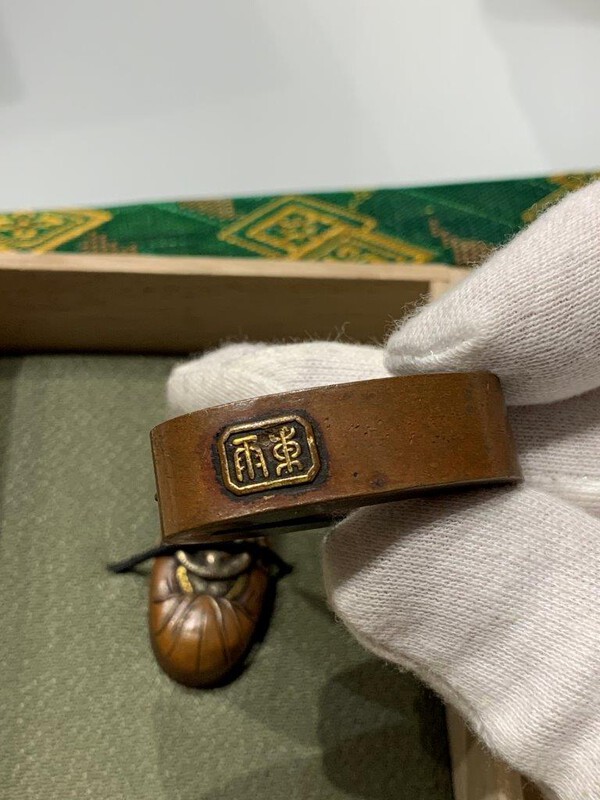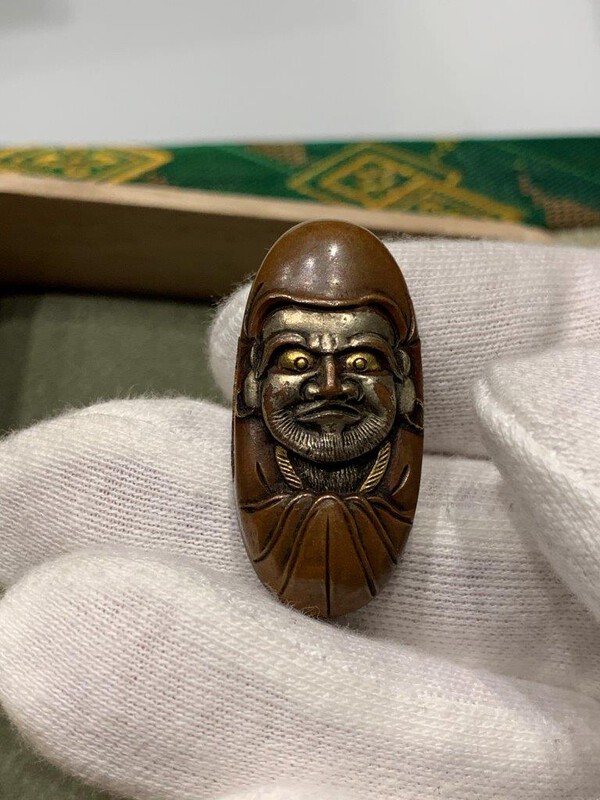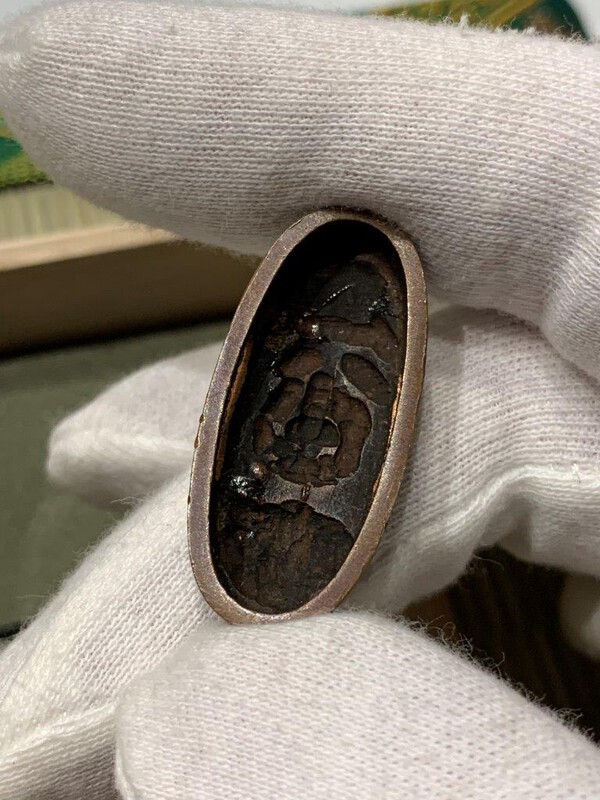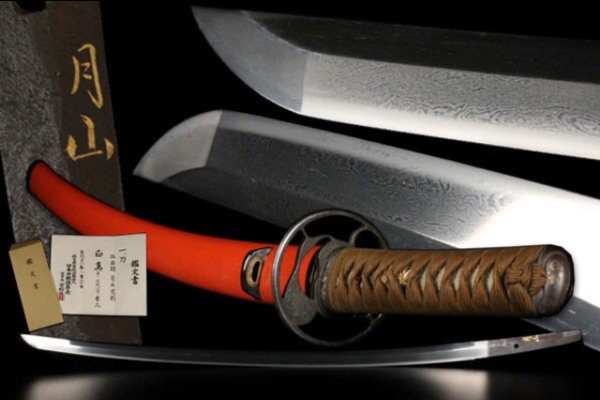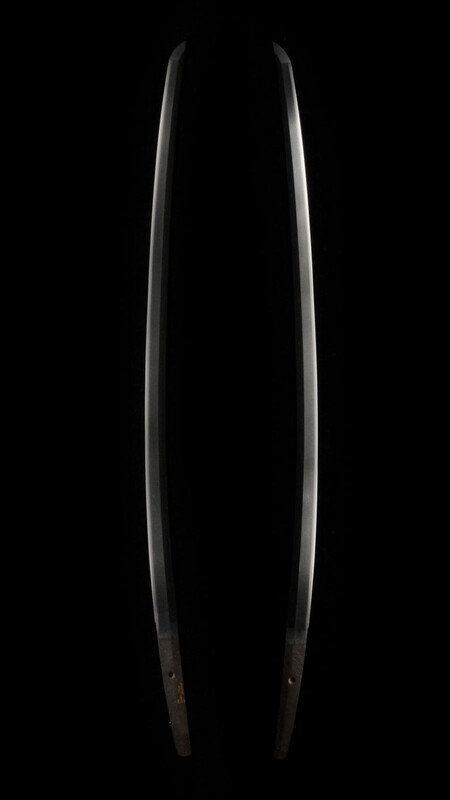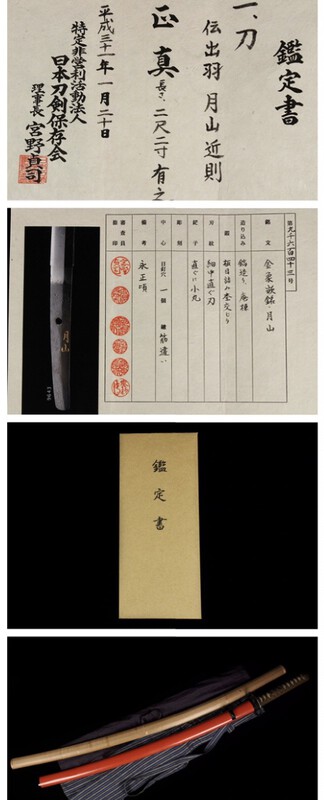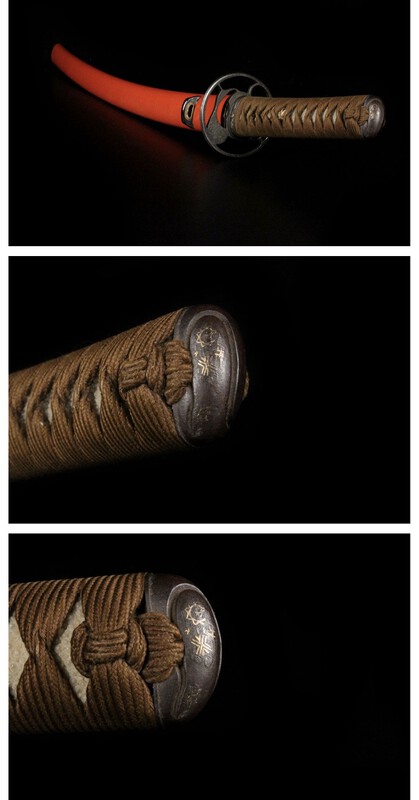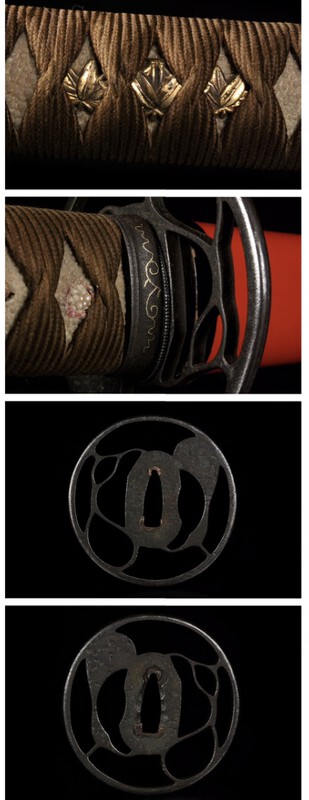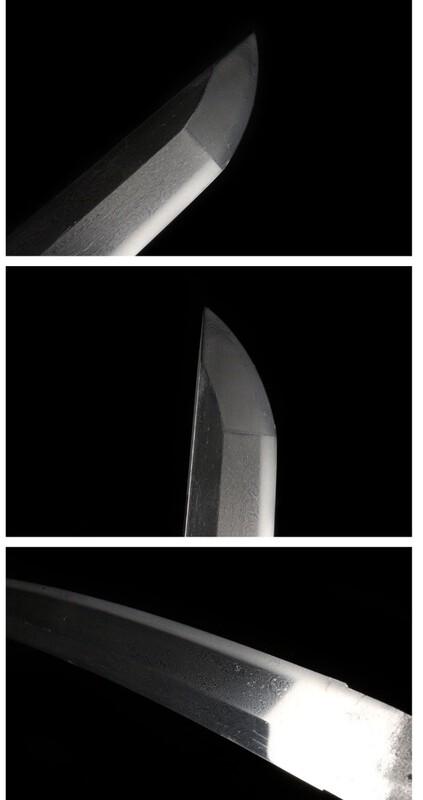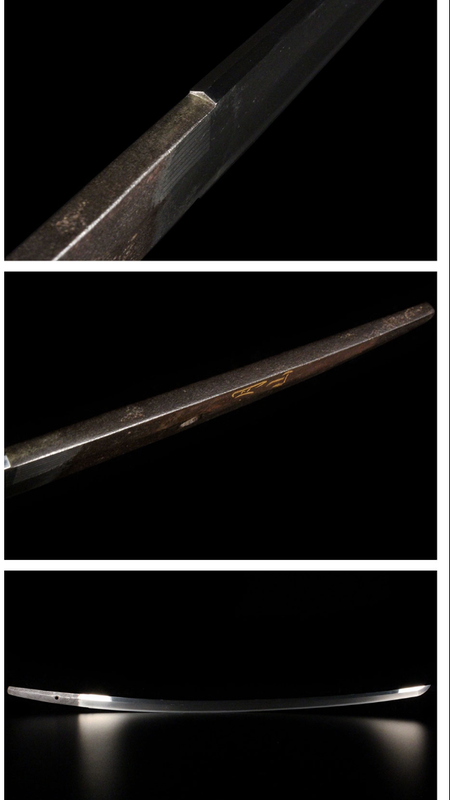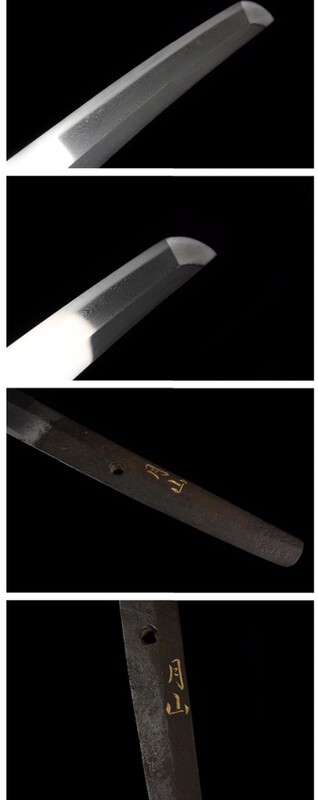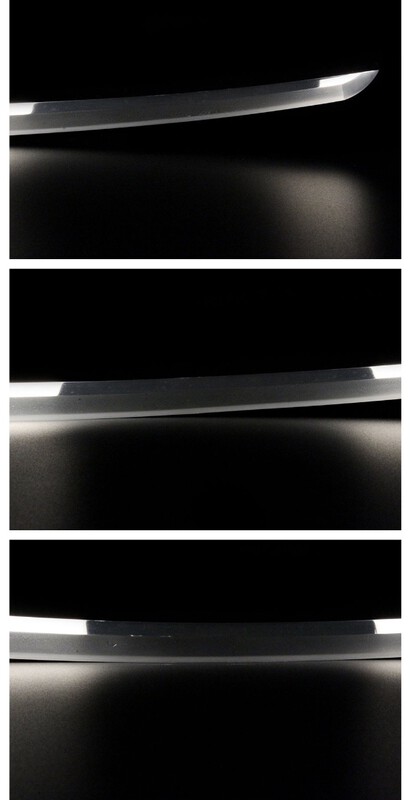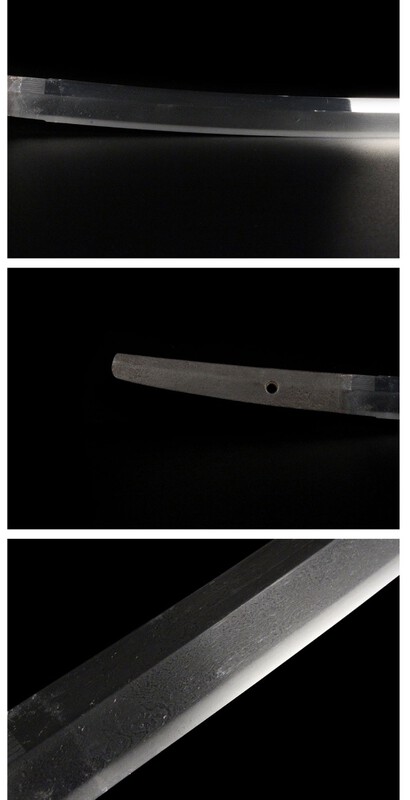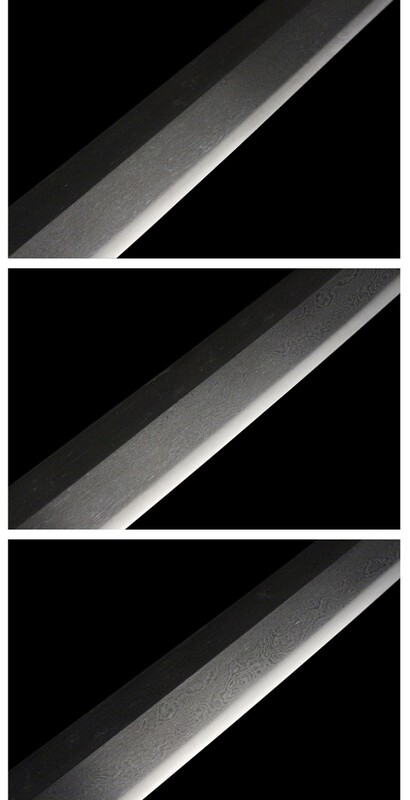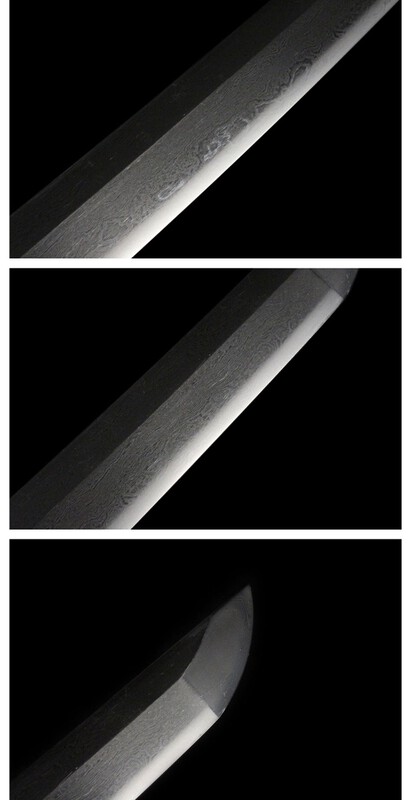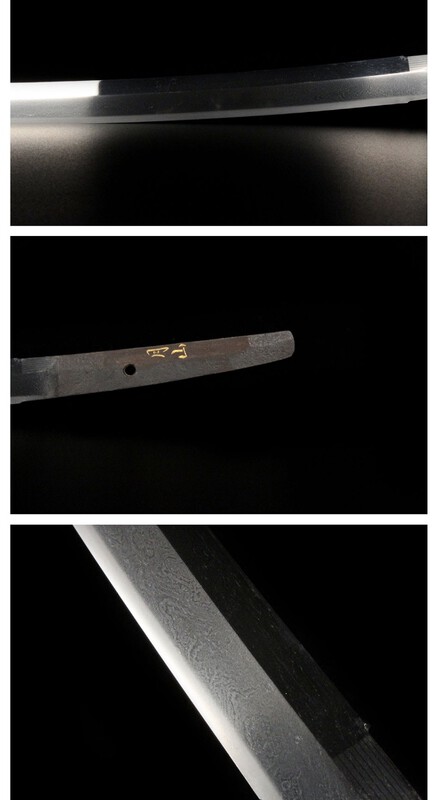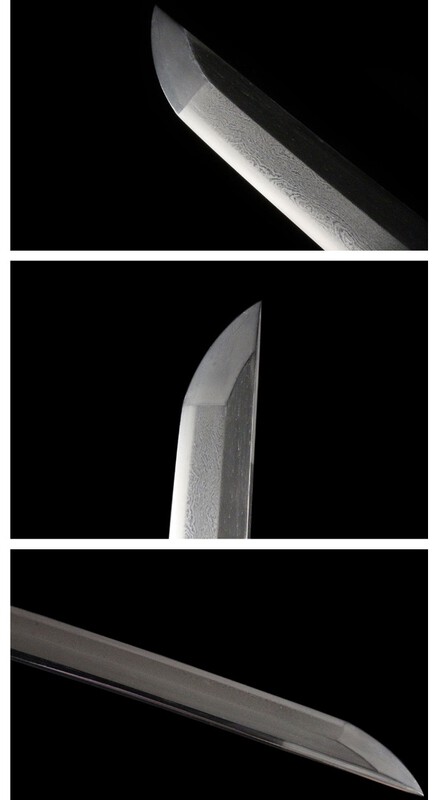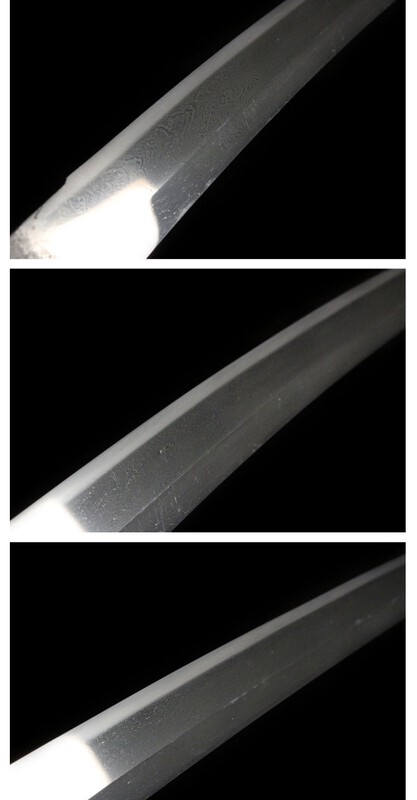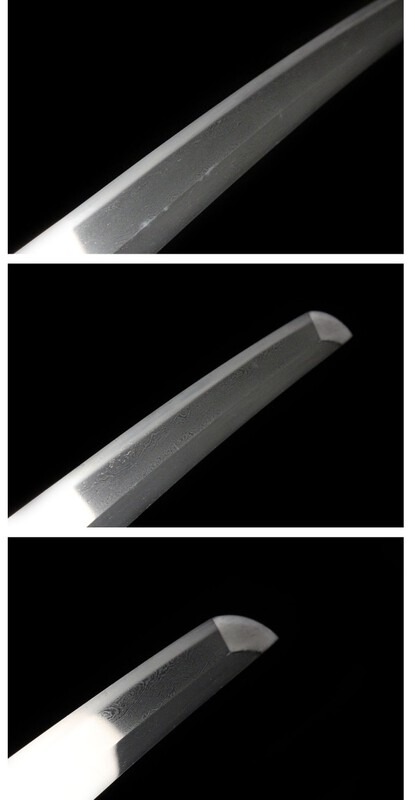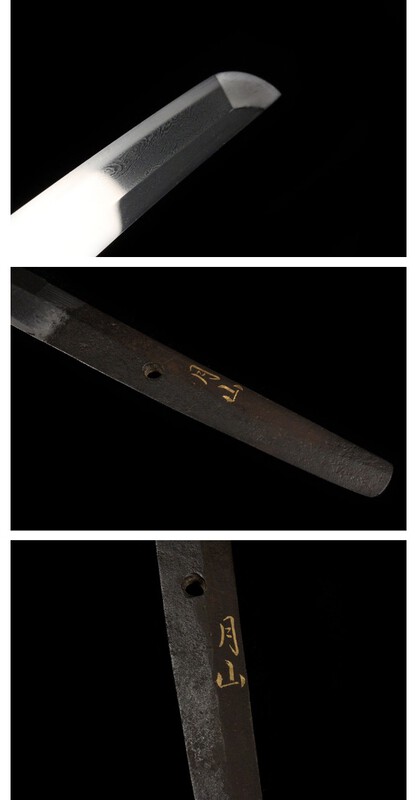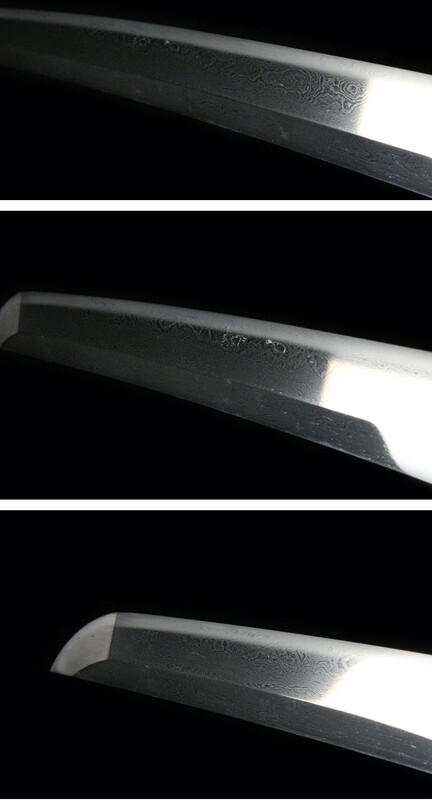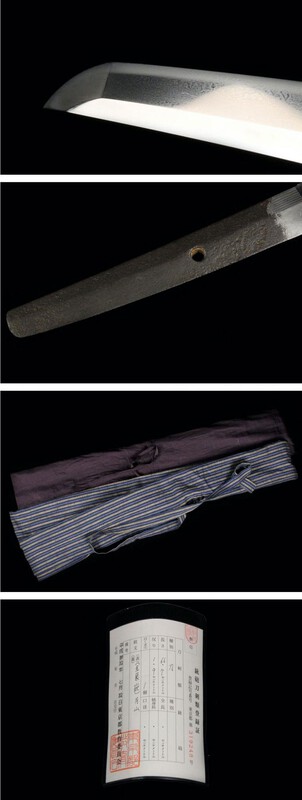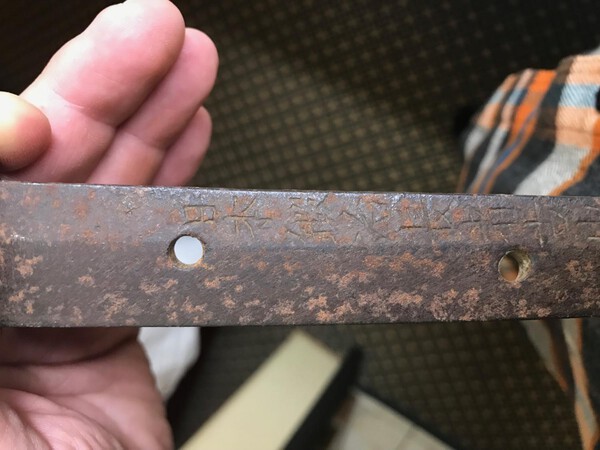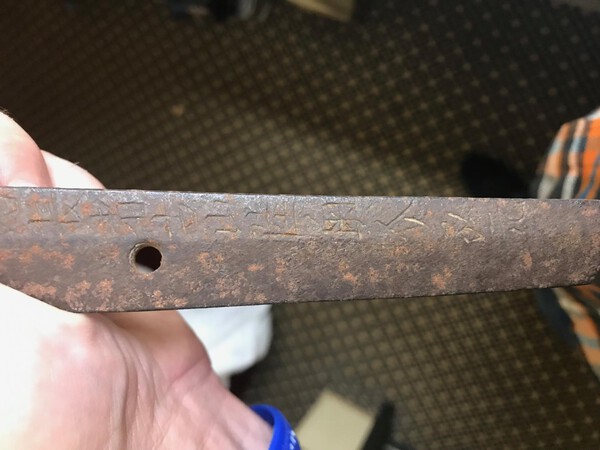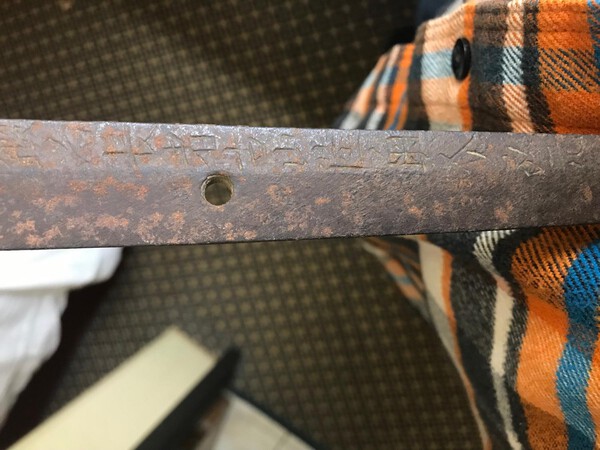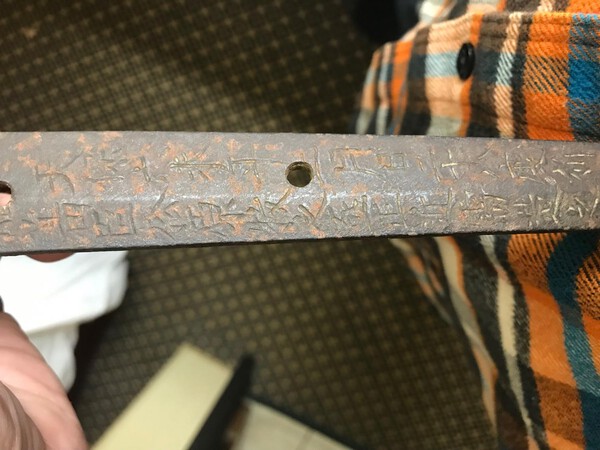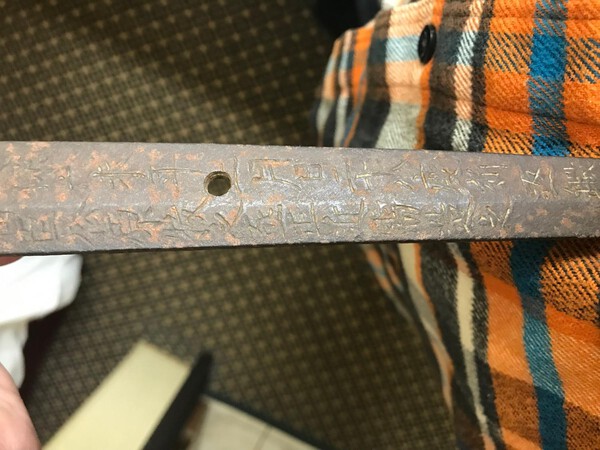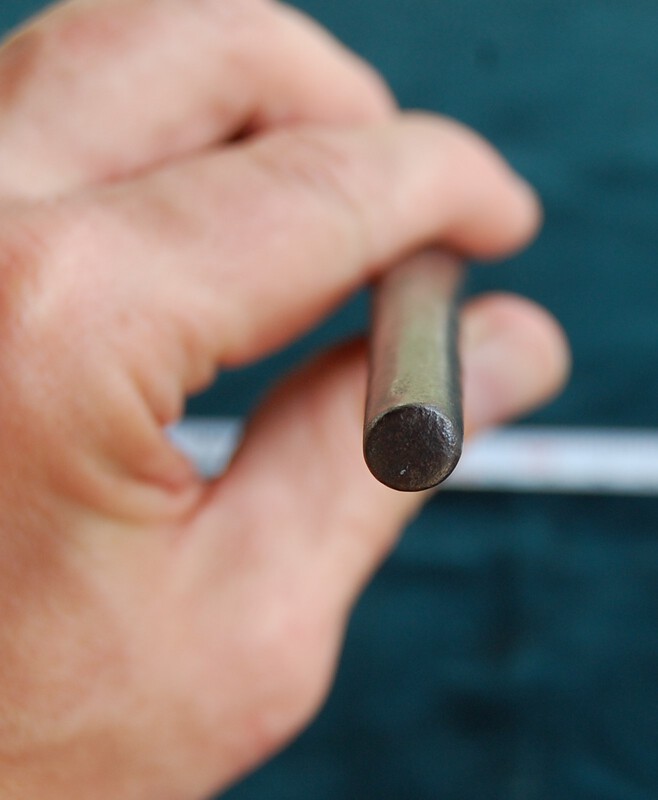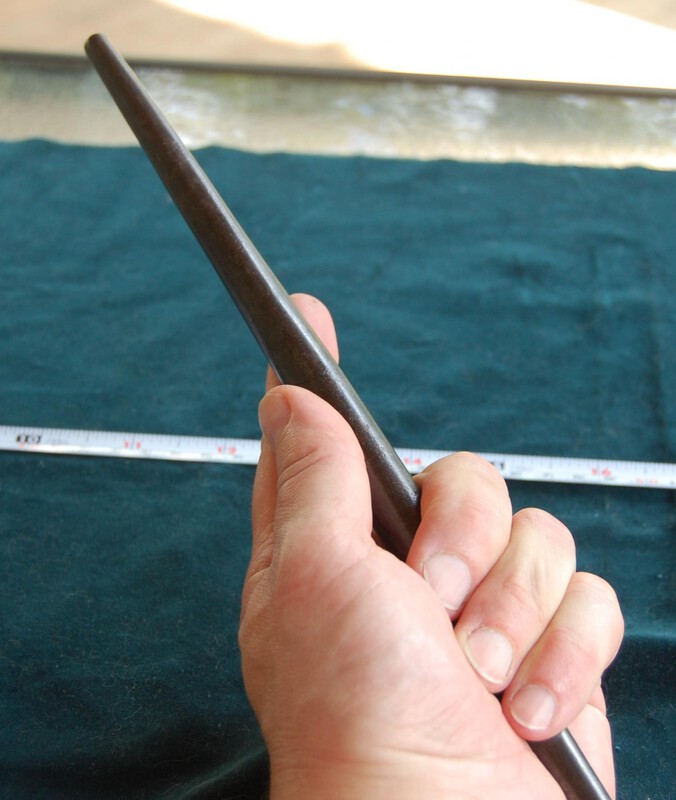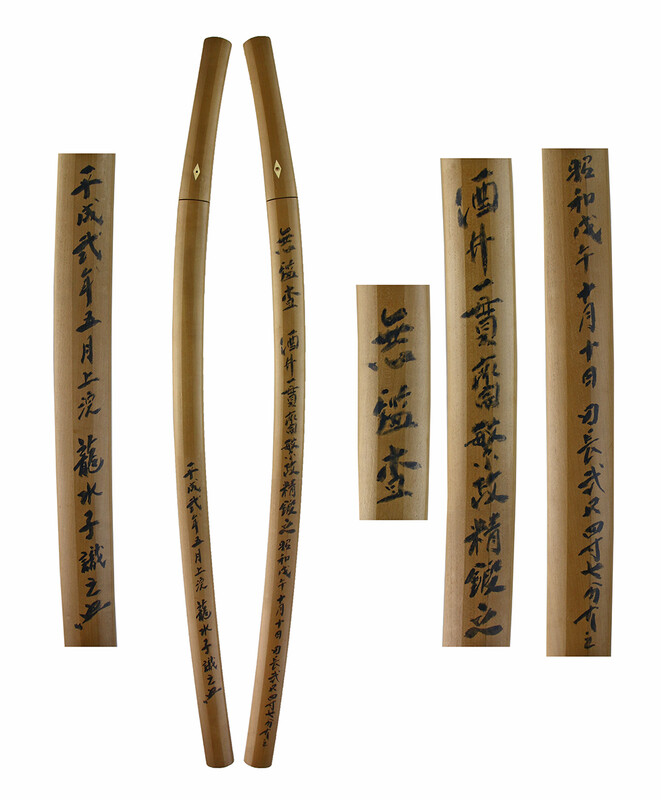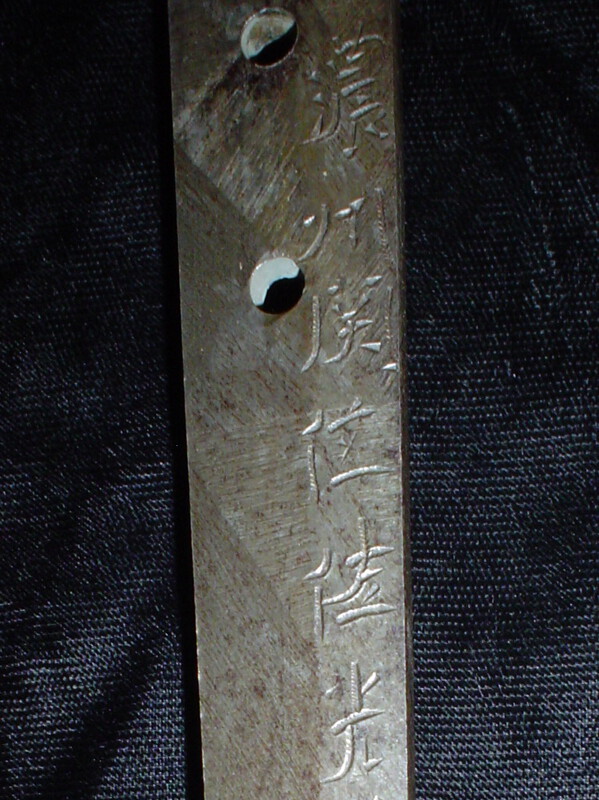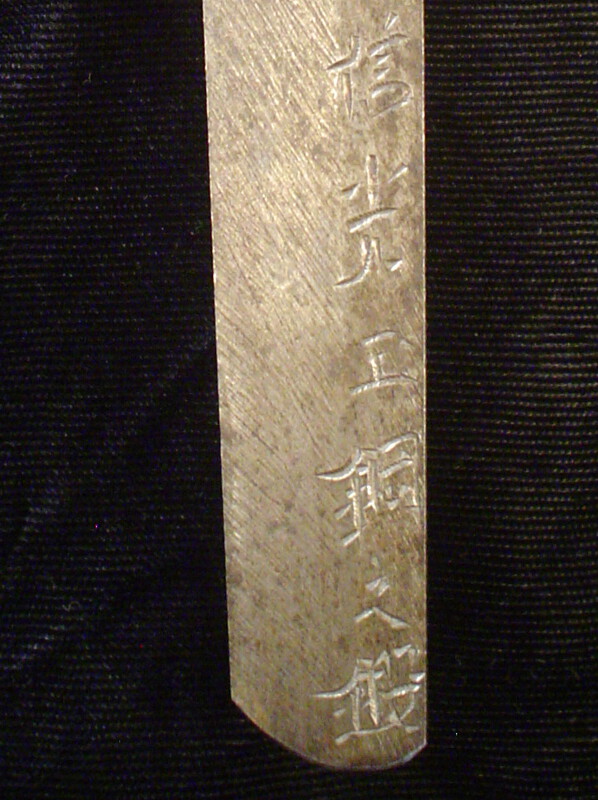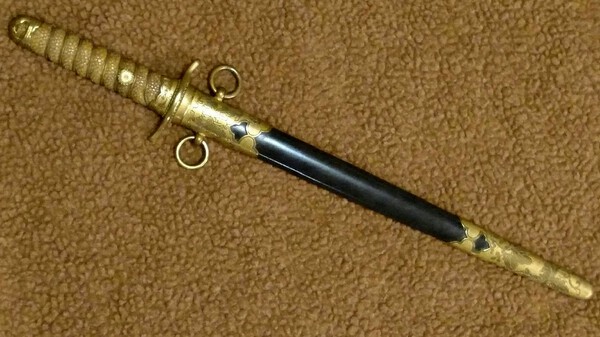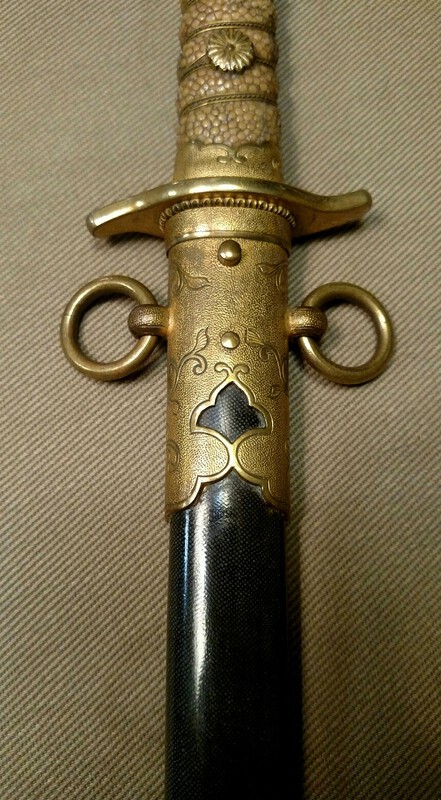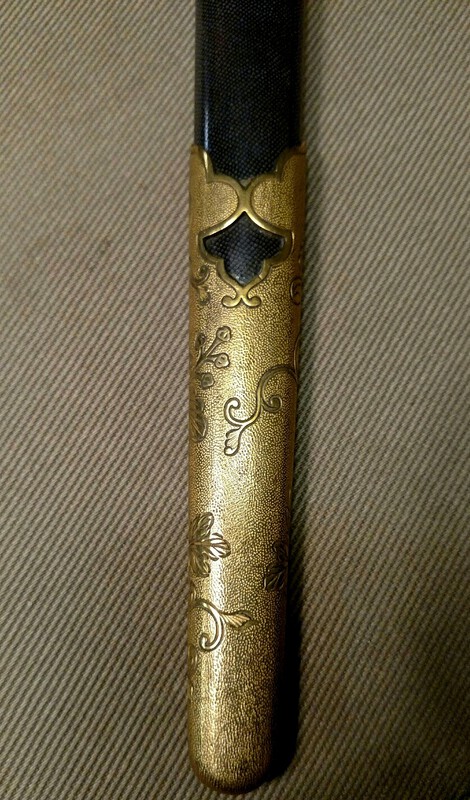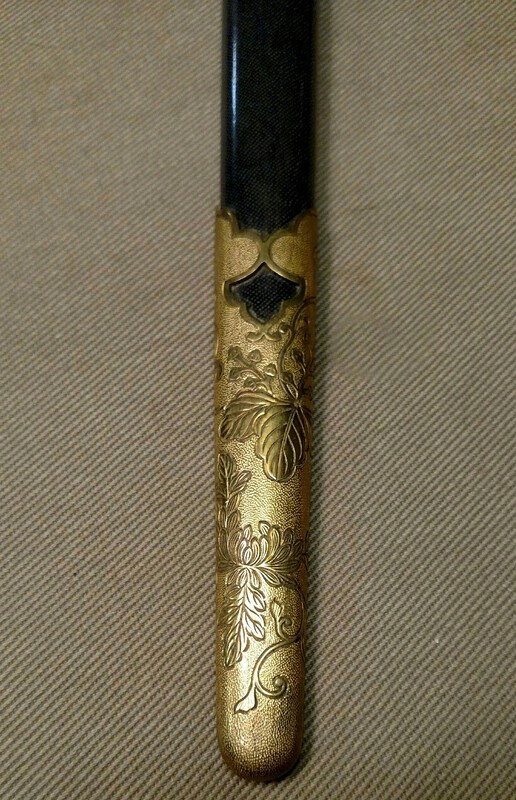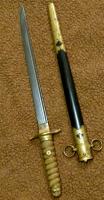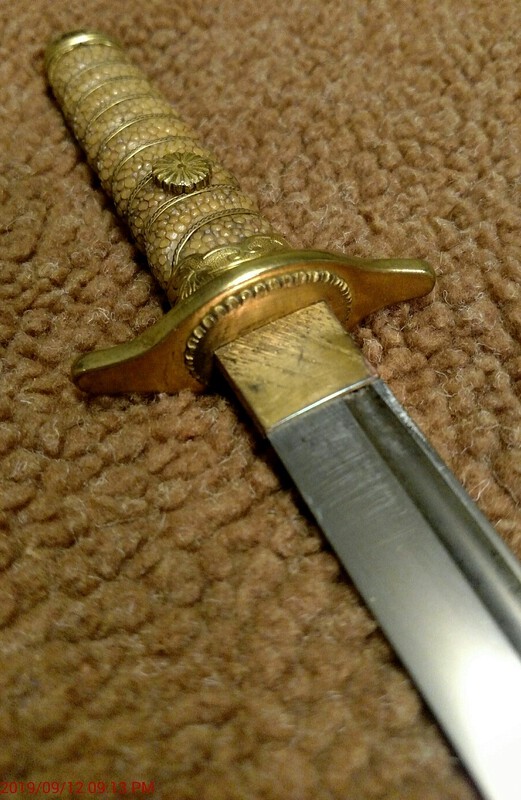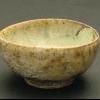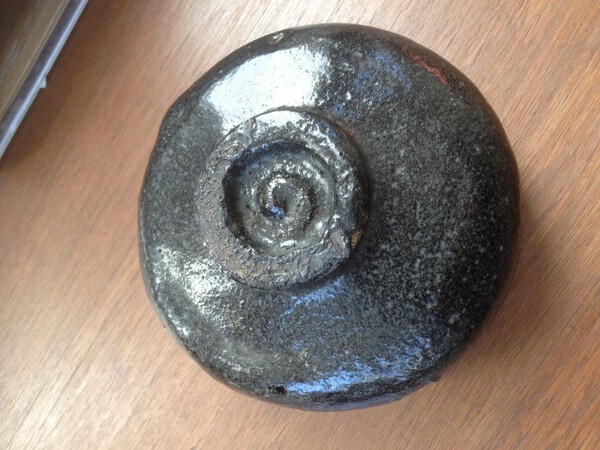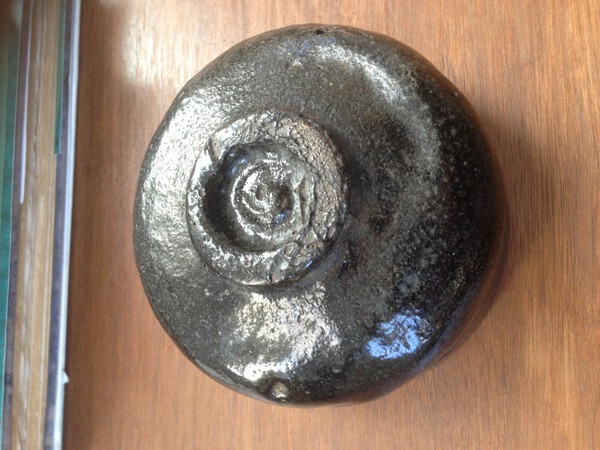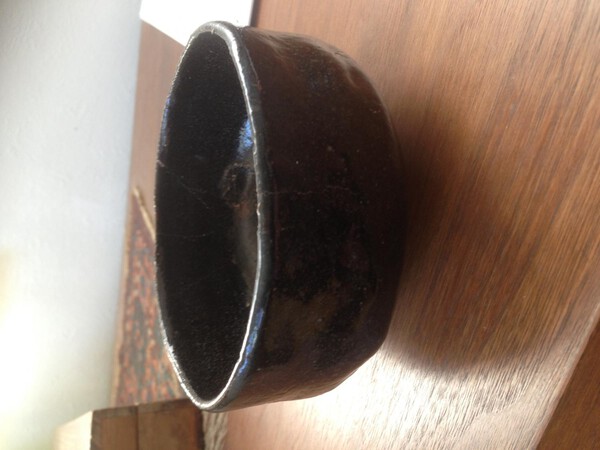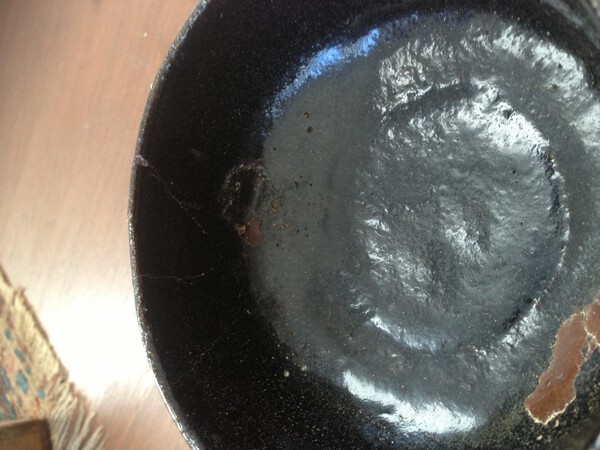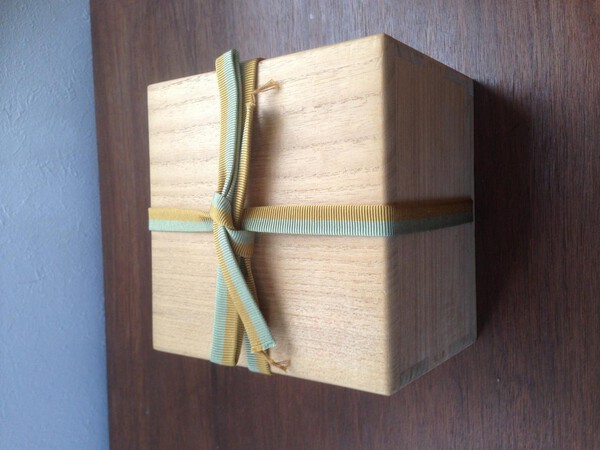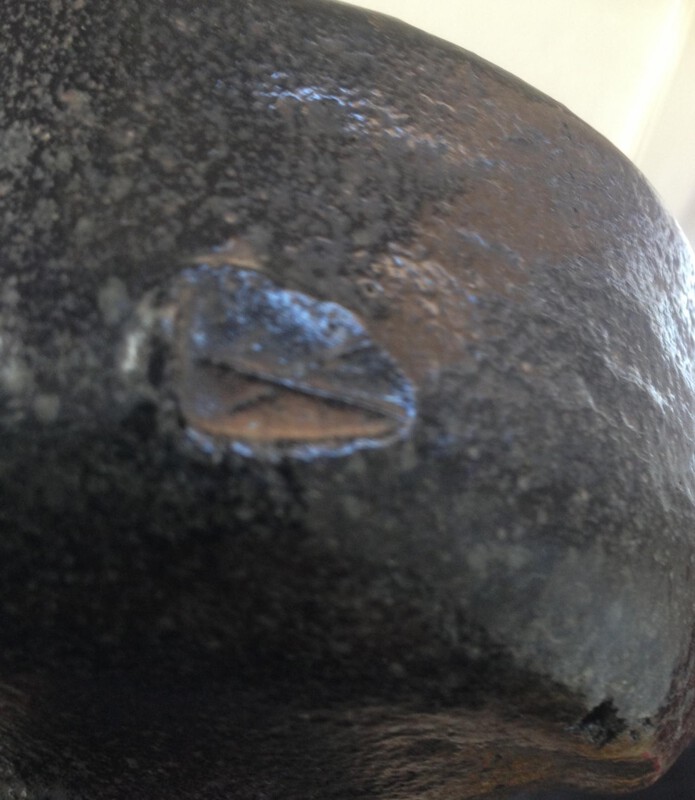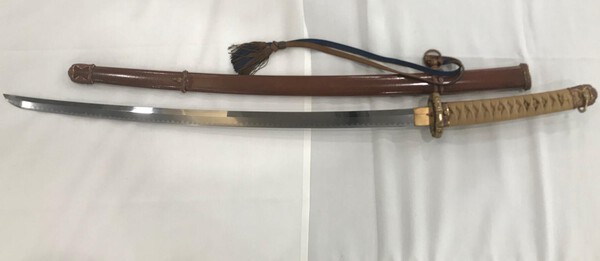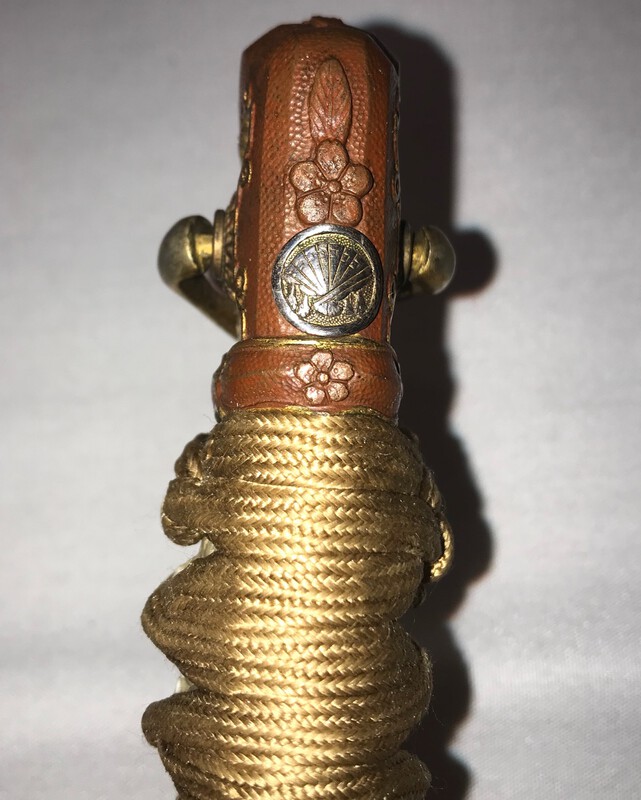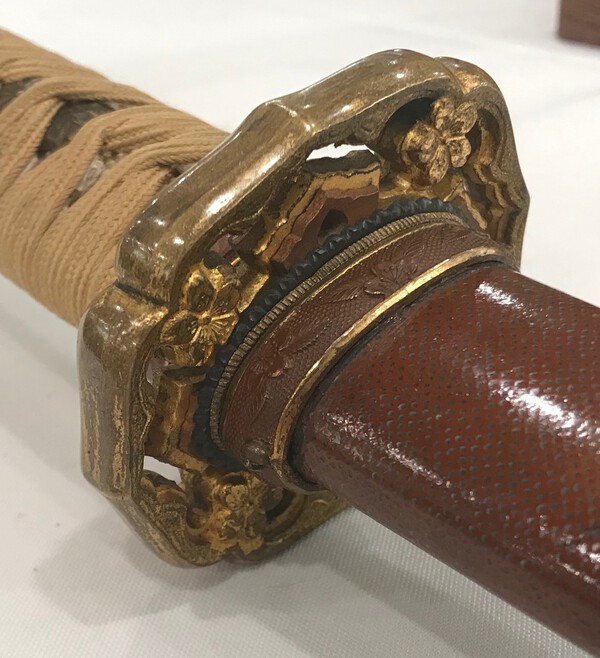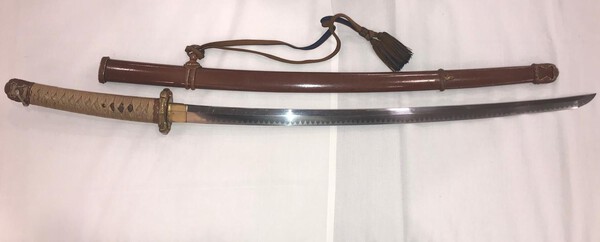Search the Community
Showing results for tags 'for sale'.
-
I offer for sale, a Spring 1943 Koa Isshin WW2 officer sword. They are rarely found in the original leather combat covers these days, which I have left on to preserve its originality. I have slightly peeled back the leather, and looks like the painted metal saya is immaculate underneath. The blade is in as found condition, no rust no pits, no chips. The features of the blade are there for the eyes to appreciate. As expected there is very slight staining with age and combat use. I love the patina on these swords that show that they have been taken to war, and not left in an office or cupboard. The mei is well cut, and the nakago is in very nice condition. To further prove its originality, the MUNE stamps are evident, and not obscured by rust that so often happens. At AUD3150, I will express post with tracking and signature any where. These swords are now very collectable and sought after, not often does an original example that hasn't been monkeyed with come up.
-
1 antique Japanese WW2 Yasukuni Shrine sword by Yasushige available. This fine antique Japanese Yasukunito sword would make an important acquisition for any collection. The blade measures 66.8 cm (26 5/16") from blade tip to notch in the blade spine. This sword is mounted in shirasaya. There are no longer any army mounts with this sword. This Yasukunito sword has NBTHK papers already—a nearly $1000 cost (when sent from the U.S. to Japan), and a many months-long process. Condition: This fine Yasukuni Shrine sword is in original, very fine WW2 polish. There are no nicks, and there is no pitting of any kind. In fact, the blade only has a very occasional micro finish scratch. The blade needs no polish, which is a significant savings in time and money as well. $6500 obo
-
1 antique 18th century Japanese wakizashi available. This fine antique Japanese sword would make an important acquisition for any collection. This sword was papered by the NBTHK, and has Toku kicho papers. The sword is signed Fujita Omi no Kami Tsuguhira. This sword is dated ‘Horeki 1754 in Spring at Toto’. The blade measures 54.5 cm from blade tip to notch in the blade spine. This sword is mounted in new shirasaya, and has been polished. So, already polished--new Shirasaya made--already papered...money, and time saved. CONDITION: This sword is in new polish. $2625 shipped to anywhere in the world
-
Very fine gold and shakudo Hosakawa motif tanto koshirae available. This koshirae has a elaborate matching Namban iron fuchi, kashira, and tsuba. The finely carved shakudo handle wrap is of the same matching design. The Hosakawa menuki are fine shakudo and gold. The fuchi, kashira, and tanto each have a dragon in their intricate carving. This koshirae holds a 9” to 12” tanto blade. CONDITION: This rare koshirae is in exceptional condition. $2400
-
1 fine NTHK-NPO Goto tosogu wakizashi koshirae available. The owner asked the shinsa group to evaluate the fuchi/kashira. The signed fuchi/kashira were affirmed by the shinsa group to be by Goto Mitsunaga. These tosogu are fine shakudo nanako with gold clan mon. These are exceptional fuchi/kashira. The shakudo horse menuki are beautiful—these may prove to be Goto as well. The koshirae are in such fine condition, that we found it hard to justify removing the menuki to get a look at their backs. This koshirae has a wood tsunagi that was fashioned after the original sword blade. The blade measures 52.4 cm. $3300
-
Hi, I am a new member to this forum but have been on other sites/forums, under my same user name, for many years. I am not an avid or very experienced Japanese Sword enthusiast but have always been interested in WW2 era items for collecting. I am listing my WW2 Shin Gunto Japanese Officers Sword here in hopes of selling it to fund some other projects of interest. I purchased this sword many years ago from a fellow WW2 collector and know little about its history or origin other that it was obtained by a returning WW2 soldier in the Pacific. I have several pics to show condition here and will send others if requested. The only issues I see are the obvious 2 dings to the scabbard and one nick to the sword blade. Otherwise it seems pretty decent overall. Please contact me through text or calls at - 309-242-1537 if interested in it. Selling for $1550.00 shipped in the US. Thanks again!
-
This WW2 officers sword is all about the custom mounts and fittings. Although the blade is a mumei 400-500 year old nihonto, the rarity is the outfit. It is extremely rare to find a sword with blackened fittings, it is very rare to find an Army sword with a shark skin saya, but what are the odds of finding both in one sword? I recon its akin to picking the 6 winning numbers in Lotto! The ancestral blade is in reasonable polish, nice hada and hamon, and a few forging openings common on swords of its age, but as I said, its about the full package. A beautiful original complete 8 seppa set, it is just one of those beautiful original Shin Gunto, that would be a joy to own and display. Putting a price on this would be like pricing the Mona Lisa, or Statue of David, there is nothing to compare it to. So USD2350 including express posting, anywhere, OR a sensible offer.
-
Dear NMB members: I have recently decided to let a few pieces go from things that I have had a my office. I am starting to work more remotely from home, and I will probably downsize the office. If you haven't decided what to buy yourself for Christmas, maybe this will fit the bill. Here's a chance to get a helmet without bleeding money. I have a 26 or 28 plate Japanese kabuto with inner lining intact, that comes with a killer demon maidate and a hambo, along with a stand (not a Japanese stand). I do not know if the helmet is signed, because I have not opened up the liner since I purchased it, I purchased it in 2015 at the SF Token Kai, and it has been in my office since then. When purchased, the helmet did not have a maidate. The center post that holds the maidate does not have a spring clip, so I have just had the maidate sitting on the center post. I was told the maidate was Edo period and rare. All I know is that it looks great on the helmet, and someone at the show offered me $500 alone to try to buy the maidate from me. The neck piece (shikoro?) has small chips in the lacquer. I will load up a close up photo in the next day or so. The neck piece (shikoro?) is not attached with rivets, but after I purchased it, I bought four helmet rivets from Japan. and I will include those with the sale. There is some lacquer missing in a few other areas The hambo is included with the helmet (not original to the helmet). Overall, a unscrewed with helmet which makes a great display piece, for a price that is below what one has to pay to own an original kabuto. I am going to make it fairly easy to get into this helmet. I am asking (SOLD) net in cash, USPS Money order, cashier's check, or Paypal ("friends and family"...I do not want to pay PayPal fees) Buyer pays shipping and any insurance costs. Alternatively (now well make it harder to resist), I will take $1,500 cash, Paypal, etc., with the same terms as with all cash, and I will ,taking the balance in trade for Japanese blades and weapons, such as hand forged katana (civilian mounts preferred), tanto, jumonji yari, original Japanese sukashi arrowheads,, antique American/English bowie knives, antique Marbles and Russell knives, Moro kris and barong, SA or SS german daggers, Civil War Cavalry sabers, Early US Gold coins, US Morgan silver dollars, and similar such items of interest. If you got into some pieces right, and want to offer such items in part trade for the balance of the helmet purchase price, I am open to considering offers. PM me with what you propose. I will add numerous photos. Thanks for looking. Regards, Bill E. Sheehan Yoshimichi)
-
When I started collecting Gunto, I displayed them with sword belts, appropriate to their rank, NCO, field, officer etc, complete with hangers. Thought it may be of interest to post them. A nice part of Japanese history. They are in the for sale section if anyone is interested.
-
Years ago, I bought this wakizashi as a learning piece for my grandson to gain an interest in nihonto. It has every feature that made it a great starter for a beginner..... Old signed Ubu blade with visible features, Saya with Kurikata, pockets for Kogai and Kogatana, a WW2 hanger, old 2 piece Habaki, and all the fittings complete. I imagined him sitting down with his Kanji book, and sword features book, gaining an interest, so that one day he may take over my collection. NOPE!!! His mother (my daughter) totally canned the idea. So is is for sale, USD 300, plus post. A bargain, sold as is, and hopefully goes to another budding collector, maybe a fantastic Christmas present.
-
I am listing some books that I have twice. All books are located in Germany - so no custom fees for EU members (and shipping is also cheaper) Lethal Elegance, Joe Earle, English, Hardcover 35,00 USD 30,00 € 2) Facts and Fundamentals of Japanese Swords, Nobuo Nakahara/Paul Martin, English, Hardcover 30,00 USD 25,00 € 3) Armures du Japon, Robert Burawoy, French/English, Hardcover 60,00 USD 50,00 € 4) Samurai Armor design, Pie books, Japanese/English, Paperback 35,00 USD 30,00 € 5) Art and the sword - Volumes Four (1991), Five & Six (1995), Eight (2001) 50,00 USD 40,00 € All books are in very good condition Postage - 5 kg Germany, insured 7,50 € Postage - 5 kg EU, insured 18,00 € Package - 2 kg US, not insured 20,00 USD Package - 5 kg, US, insured 40,00 USD Payment options: Paypal (Friends&Family), Wire Transfer (I will provide my IBAN) Thanks for looking, Stephan
-
Large release from my collection – few fine kozuka 1. Fukurokuju and crane kozuka Lovely kozuka with longevity motif. Omote side mostly in usuniku-bori, ura side in motobori techniques. Mumei Price: $600 2. Hotei and Karako kozuka Interesting kozuka in usuniku-bori technique, manji pattern on Hotei’s bag. Very nice work. Mumei Price: $500 3. Dragon kozuka Top class Goto kozuka. Dragon details are exquisite, nanakoji is perfect as it should be. Signed: Goto Kanjo Kao (H 02638.0), Hachirobei line Price: $600 4. Centipede kozuka with kogatana Not often you can catch one. Nice work, centipede running through a rotten bridge pillar. Signed: Masayuki Price: $600
-
Large release from my collection – some fine fuchi-kashira 1. Tigers f-k Craftsmanship in the essence. Look at the details, brilliant nanakoji, inlay work, carvings. Masterpiece grade item. Signed: Omori Teruhide Kao Price: $1000 2. Shishi f-k Nice f-k. Good example of the Yokoya school. Fine motobori techniques realized. Signed: Soyo Kao Size:Fuchi: 37.5 x 21 x 12.6 mm Kashira: 33.6 x 16.2 mm Price: $300 3. Huang Shigong (Kosekiko) and Zhang Liang (Choryo) f-k This is something really rare. Motif is quite popular but not so many items out there, especially f-k and this one is a true find. Fuchi is very nice, black shakudo dragon in golden waves, kashira is something special, miniature scene from the famous legend on finest nanakoji, you can see every detail, bridge surface is polished to mirror. A true masterpiece. Mumei Kyo-Kinko NTK Kantei-sho Price: $600 4. Kirimon f-k Very interesting f-k by the master of minute carvings Hosono Masamori. Signed: Hosono Sozaemon kore o horu Sizes: Fuchi: 3.7 x 1.9 x 0.8 cm Kashira: 3.3 x 1.7 x 0.6 cm Price: $400 5. Daruma and mokugyo/hossu (Zen Buddhism drum and brush) f-k Famous design, nice work. Signed: Tou (in-mei) Sizes: Fuchi: 34 x 17 mm Kashira: 31.6 x 12.5 mm Price: $350
-
Collectors--St. Croix Blades has 12 swords listed for sale up on eBay currently. They run the gamut--from Buy It Now listings to Auction listings, from Showato to gendai, from fully polished to as-is. Take a look to see if there is anything you might be interested in. Here is the link: https://www.ebay.com/sch/m.html?_odkw=Japanese+swrod&_ssn=stcroixblades&item=362883002543&_osacat=0&_from=R40&_trksid=p2046732.m570.l1313.TR11.TRC2.A0.H0.Xjapanese+sword.TRS1&_nkw=Japanese+sword&_sacat=0 Those of you who don't have an eBay account--or who want a lower price (I'll subtract the fees from the listed price), contact me for a direct sale. Thank you! Matthew Brice www.StCroixBlades.com
-
Hello everyone! I thought I would introduce myself. My name is Octavian and I'm from Canada. I'm new to this community! I have an interest in learning about anything from the Japanese culture. One of my interests over the last few years has been collecting and learning about nihonto Japanese blades such as the Katana and the Tachi. I have a very nice example for sale! I love this nihonto but I'm selling it to feed my other hobby, Japanese anime, original production anime celluloids. I look forward to learning new things and sharing this hobby with you as part of this community! ~~~~~~~~~~~~~~~~~~~~~~~~~~~~~~~~~~~~~~~~~~~~~~~~~~~~~~~~~~~~~~~~~~~~~~~~~~~~~~~~~~~~~~~~~~~~~~~~~~~~~~~~ Den Dewa Ko-Gassan Gold inlay Nihonto Katana, Muromachi Era: 600 yrs (NTHK-NPO Kanteisho papered certificate) Price: SOLD Serious Offers considered payment: paypal (with buyer protection) Certification: Certificate No. 319248, Tokyo (photocopy included: original kept in Japan) Judgement Paper: NTHK-NPO Kanteisho (authentic swords paper) This is the second highest and more commonly seen origami certificate from the NTHK-NPO that offers a generous amount of information on the sword’s characteristics. The certificate will be issued for swords of considerable quality in which the mei (signature) is authentic OR in the case that if sword is mumei(unsigned), the judges will offer their opinion on who the smith or school was that forged the blade. Blade: Mumei signature: Gold inlay: Gassan Age: Mid- Muromachi era: ca. 1400 Length: about 95cm Blade length: about 66.7cm warp: about 1.9cm first nail hole: one original width: about 26.9mm Motoshige: about 6.5mm destination width: about 18.5mm Sakikasane: about 5.1mm blade weight: about 604g Shape : It is wide and thick long size katana. It has deep curve. Jitetsu : Ayasugi hada well grained with jinie attached. The ayasugi hada is well seen. Hamon : Nie plate suguha Edo Katana Koshirae Fittings: Fuchi: Higo Deito Iron fittings (dragonfly & floral pattern gold inlay) Tsuba: High quality round shape iron tsuba with carved partterns, Edo period Saya: Red lacquered saya (sheath) Edo Period: 400 years old Accessories: Silk Bag, NTHK certificate, Shirasaya (wood housing) included, wood blade included Description: This piece is quite old Ko-Gassan. In the koto times, most Gassan smiths signed with the school name only and so the names of individual smiths are mostly lost to time. This katana matches the features of the late 1400 period and early 1500 period, and bears the hallmarks of ayasugi hada and narrow sugu samishii hamon well. It is signed in gold inlay with the school name only, Gassan as was the tradition of the school. This katana makes it a nice representative piece of the Gassan school for a collector to own. It is also accompanied by very nice koshirae of late Edo period. This blade is a long 95cm total length which (per the accompanying NTHK certificate) dates to the mid Muromachi period. This katana is a beautiful example of a Gassan smith from the muramachi era. Japanese swords are made from folded steel. These lines are visible and known in Japan as a katana Hada. These lines will depend on how many times the blade was folded. Masame hada is produced when the steel billet is repeatedly folded over in the same direction with the sides of the billet being used to form the face of the blade. The lines seen in the grain therefore represent the 'stack' of layers formed during the forging process. Ayasugi hada is basically masame hada which has been distorted by systematically varying the strength of the hammer blows along the blade during forging. The Ayasugi hada is brilliant and a standout on this sword which comes fully mounted and adds to the value of this blade. The hada is a rich looking ayasugi that has some coarseness as in many koto gassan blades. History: The Gassan school derives, as its name suggests, from Mt. Gassan in the old province of Dewa (present-day Yamagata prefecture), and is characterized by a wavy grain called ayasugi hada. According to tradition, it was founded by a smith named Kiomaru (or Kishin Dayu, as he was also known), who lived in the sacred grounds of Mt. Gassan back in the 12th century. Ever since, swordsmiths have flourished at the foot of Mt. Gassan, and a number of masters have appeared, in a long succession. From the Kamakura period through the Muromachi period, swords inscribed with the Gassan signature were famous all over the country for their practical usefulness and the beauty of their ayasugi hada, but when the Warring States period ended at the end of the 16th century, the number of blacksmiths dwindled. From the start, Mt. Gassan was a site of mountain worship, and the blacksmiths who lived there were peculiar people who secluded themselves among the mountains to purify themselves before forging swords. They were ascetics, similar to Shugendo practitioners. Gassan was the name of the object of worship, and inscribing such a name on a sword would normally be inexcusable. Probably Gassan swords were originally intended for funeral rites, rather than as weapons. They were not meant for killing people, but were associated with the faith, I believe. The Gassan school’s ayasugi hada layer appeared when steel with different carbon contents were mixed and combined at a certain point, but the formula was kept secret. At the end of the Edo period, Gassan Sadayoshi, who was the successor to the Gassan smiths, moved to Osaka. I believe he wanted to show the world the Gassan spirit one more time. The Gassan school origins remains to this day one of the most prestigious and successful lines of sword forging. The roots of Gassan extend far back into the Kamakura period (1185-1333 AD), and it is suspected perhaps even as early as Heian period (794-1185 AD). The home of Gassan was in Dewa province in the northern region of Honshu where they were the only indigenous school to Dewa. The name “Gassan” actually refers to one of three sacred mountains of Dewa, or “Dewa Sanzan”, the other two being Mt. Haguro and Mt. Yudono. It is a very mountainous and remote region, and was even more so in the earliest days of the school. From the very earliest works of the Gassan school, they exhibit a type of hada called “Ayasugi” which is comprised of long evenly undulating stacked wave pattern. Interestingly enough this pattern of the same name is carved in the interior walls of the body of the Shamisen (a guitar like musical instrument) to improve the tone. This pattern eventually became the hallmark of Gassan works and is often referred to as “Gassan Hada” as it continued to be refined and perfected by the Gassan smiths up until the current Gassan head and Living National Treasure smith, Gassan Sadatoshi. The Gassan school faded from view around the beginning of the 17th century, and then was revived with Gassan Sadayoshi who was born in 1780. Sadayoshi traveled from Dewa to the forge of Suishinshi Masahide, who was striving to rediscover the techniques of Koto masters. Masahide was a proliferate teacher, and is said to have had over 200 students. Sadayoshi became one such student and later settled in Osaka to open his own forge. The line was re-established with him and his adopted son, Gassan Sadakazu became the heir to the line entering very difficult times for swordsmiths; the Meiji Restoration. The Samurai class was effectively abolished and swords were no longer a weapon that could either be worn, nor were they in much demand as Japan Westernized, so swordsmiths were relegated to finding work in other trades. Many turned to tool making, blacksmithing, or other related trades. However Gassan Sadakazu contined on with sword making and found a market making copies of famous swords for influential and affluent clientele, as he was quite gifted in making swords in the Bizen, Soshu, and Yamato traditions. He became a Teishitsu Gigeiin or “Artist under the Imperial Household” and thus was called upon by the Imperial Family to make swords that would be worn, or bestowed as gifts by the Imperial Family. He survived the times and his son, Gassan Sadakatsu, would become the luminary smith of the 20th century, and also receive the dedicated patronage of the Imperial Family. If you take a look at the blade first of all the forging structure catches the eye. It appears as continuous waves from the base to the tip whereas the valleys show some mokume areas. The jihada stands out and the steel is blackish. So all in all we have the typical characteristics of the Gassan school and an ayasugi-hada is therefore also called Gassan–hada. The hamon bases on gunome/notare/sugu-ha midare but the waves of the jihada force it into a notare-like appearance. The nioiguchi is subdued and the entire jiba lacks clarity and brightness. Thus this is a typically rustic work of that school and all and all typical Gassan.The koshirae is en suite and of dragon motif. There is a deep rich brown sageo and tsuka-ito to match. The rayskin ( same ) is black as well as the lacquer finish of the saya. Japanese dragons and the koshirai (日本の竜 Nihon no ryū) are diverse legendary creatures in Japanese mythology and folklore. Japanese dragon myths amalgamate native legends with imported stories about dragons from China, Korea and India. The style of the dragon was heavily influenced by the Chinese dragon. Like these other Asian dragons, most Japanese ones are water deities associated with rainfall and bodies of water, and are typically depicted as large, wingless, serpentine creatures with clawed feet. The modern Japanese language has numerous “dragon” words, including indigenous tatsu from Old Japanese ta-tu, Sino-Japanese ryū or ryō 竜 from Chinese lóng 龍, nāga ナーガ from Sanskrit nāga, and doragon ドラゴン from English “dragon” (the latter being used almost exclusively to refer to the European dragon and derived fictional creatures).
-
Purchased from Kinokuniya in Tokyo who bought it as part of a collection of unusual weaponry. Unfortunately it appears to have been overcleaned by a previous owner but there is still good patina visible. In the hand it feels old and authentic, is gorgeously balanced, fast, smooth and feels great. While I cannot be 100% sure in terms of age (it is very unusual) I would agree with Kinokuniya who told me it was from the Edo period. Measures 33.8 cm long x 16 mm wide at center by 6 mm wide at tip. One tip is Weighs a hefty 12 ounces (340.2 grams) $450 plus shipping
-
Greetings to all, Moving few blades to new caretakers to fund my new terrace and perhaps a new nihonto. So anyone interested in high quality ”younger” blades, heads up. Special thanks to Joe, previous owner of two of them, for lending me his website and descriptions plus photos. First one is a gassaku blade by Miyaguchi Ikkansai Toshihiro (Yasuhiro) and his son Miyaguchi Tsunetoshi Small transcipt to romanji courtesy of Markus Sesko: Ise-jingû go-jinpô-ken no yotetsu o motte “made from steel that was left over from making a treasure sword for the Ise Shrine” Tôto-jû Miyaguchi Ikkansai Toshihiro dô Tsunetoshi kinsaku Shôwa kinoe-umadoshi chûshû kichijitsu “on a lucky day in fall of the year of the horse of the Shōwa era [1954]” Tanaka Shûichi-shi no motome ni kotae Not sure about the reading of the commissioner's first name Shûichi. Can also be Hidekazu or Hideichi. The blade was made from steel that was left over from making a treasure sword for the Ise Shrine renewal ceremony. But it has to be understood in a positive way, i.e. not just as "leftover" steel but emphasizing that the very same selected/quality steel was used as for the sacred treasure sword replacement procedure. Link to information and photos here, more on request. https://www.jsc-mw.com/miyaguchitoshihirotsunetoshidaito Asking 8500€ for this magnificent blade made of highest quality of materials. ____________________________________________________________________________________ Second blade is from Ozawa Masatoshi a student of Miyaguchi Toshihiro a long and massive ububa blade. Link to photos and information here: https://www.jsc-mw.com/ozawamasatoshidaito Asking 6000€ for this one, beautiful activities to study and marvel. Please feel free to ask more photos and information. ____________________________________________________________________________________ Third and last but not least is blade by Sakai Ikkansai Shigemasa, long and beautiful blade made on order. Few photos from Aoi below and here is the translation courtesy of Markus Sesko on both mei and sayagaki: Mei: ”Sakai Ikkansai Shigemasa kore ko seitan (酒井一貫斎繁政精鍛之, “carefully forged by Sakai Ikkansai Shigemasa”) – Setsuyō Amagasaki-jū Negi e -shi no motome ni kotae (應摂陽尼崎住根木栄英氏需, “made on orders of Mr. Negi Shigehide, resident of Amagasaki of former Settsu province”) Shōwa tsuchinoe-umadoshi jūgatsu tōka (昭和戊午年十月十日, “October 10 in the year of the horse of the Shōwa era [1978]”)” Sayagaki: ”鑑査 酒井一貫斎繁政精鍛之 昭和戊午十月十日刃長弐尺四寸七分有之 平成弐年五月上浣 龍水子識之「花押」 Mukansa – Sakai Ikkansai Shigemasa kore o seitan Shōwa tsuchinoe-uma jūgatsu tōka hachō 2 shaku 4 sun 7 bu kore ari Heisei ninen gogatsu jōkan Ryūsuishi kore o shirusu + kaō Carefully forged by the mukansa Sakai Ikkansai Shigemasa On Otober 10 in the year of the horse of the Shōwa era (1978) – Blade length ~ 74.8 cm Written by Ryūsuishi in the first third of May of 1990 + kaō” Blade information and measurements courtesy of Aoi Art: Katana in Shirasaya (guarantee NBTHK Hozon Token) has NTHK NPO papers Signature : Sakai Ikkansai Shigemasa Seitan No Mune Tame #33 birthday Born commemoration Ou Setuyo Amagasaki Negi Eiei Uji Jyu Showa 53 Nen 10 Gatsu 10 Hi Sayagaki :Mukansa Sakai Ikkansai Shigemasa Kitae No Syowa Tsuchinoe Uma Nen Oct. 10th (We divide 4 sections for each sword as Saijyo saku, Jyojyo saku Jyo saku and regular saku) This sword belongs to Jyojyo saku ranking. The blade is polished by good polisher. Habaki : Gold failed double Habaki. Blade length : 75cm or 29.5 inches. Sori : 2.1 cm or 0.83 inches. Mekugi : 1 Width at the Hamachi : 3.13 cm or 1.23 inches. Width at the Kissaki : 2.3 cm or 0.9 inches. Kasane : 0.66 cm or 0.25 inches. Era : Showa 53 (1978) Shape : The blade is long, wide and thick with deep sori, nice looking shape. Jigane : Koiitame hada well grained with jinie attach clear nice texture. Shinogiji : Koitame hada small samanagare hada. Hamon : Niedeki gunome midare with ashi. Midarekomi style Boshi. Special Feauture : Sakai Ikkansai Shigemasa was called sakai Shigeru. Showa 8th year he enrolled in Yasukuni Tanrenjyo (Yasukuni forging workplace) Showa 16th Rikugun Jyumei Tosho. His forging period in Yasukuni Shrine. He became Mukansa swordsmith in Showa 56, Mukansa sword smith is strictly choosen by NBTHK. He was good at Toshinbori(blade engraving) and made excellent engraving works. From AOI Art : This splendid blade looks Hosokawa Masayoshi’s works. The orderer was Negi Eiei, one of the famous Japanese sword connoisseurs, so that the blade is forged very well. Aoi Art estimation paper : whole Oshigata. Asking 8000 € for this one, please feel free to drop me a line to get more information or discuss sales. All prices are asking prices, will negotiate a bit on them, especially if you are in a mood to start your own Ikkansai collection by acquiring more than one of them. Have a splendid day everyone! Br, Antti
-
Hello collectors. I have a great handmade gendaito sword for sale. The nakago literally says it was made with tamahagane--which makes it pretty cool. In this case, you don't have to guess traditionally made or not? 'Made with Tamahagane'--uh, let me guess. I am double-checking my translation of the mei. I get 'Noshu ju Seki Sato Sukemitsu Nobumitsu Tamahagane kore tsukuru'. But I would like to make sure I have it EXACTLY right. Can you guys help me out with an exact translation? Thank you. --Matt Brice 715-557-16888
-
I am taking a bit of a leap and am auctioning off 3 swords. Each ends on eBay on Sunday night. Please take a look at them. You can contact me here in the message board, through eBay, or direct info@stcroixblades.com. Here are the links: 1. https://www.ebay.com/itm/362762540154 2. https://www.ebay.com/itm/362762540156 3. https://www.ebay.com/itm/113898616059 --Matt Brice www.StCroixBlades.com
-
Dear NMB Members: I recently acquired this nice iron Bushu ju Masafusa tsuba with some other pieces from a collector who purchased this piece in the very early 1980's. It comes with a custom fitted box. I am going to offer it to the NMB members first for a couple of days, then likely upload it to Ebay. There are no papers with it. The piece measures approximately 2-7/8ths inches high by 2-3/4 inches wide. The price is $800. Buyer pays all shipping and insurance costs. Payment by Paypal ("Friends and Family). PM me with any questions. Thanks for looking. Sorry for the sideways images. I saved them in the right configuration, but when I upload them to the NMB, they are uploading sideways. I took the photos with my cellphone. Regards, Bill E. Sheehan (Yoshimichi) Attached Thumbnails
-
I hope no one objects to listing a tea bowl on a sword site. I think there is quite a lot of cross-over between nihonto and yakimono. The arrival of a new tea bowl or sake cup is said to impact tv and Internet usage here just the way the arrival of a new sword does. This bowl is full of age and interest and I'd like it to go to someone who also appreciates swords. It's got plenty of ancient repairs and filled cracks but the koudai is vigorous, the 'door' like a hole in a wet rag, the 'skin' as scaly as a lizard's. 294 gms. The mark from the tool used to remove from the kiln shown in last pic. Sound and usable! Box and ribbon are new 11.7 x 6 cms approx US$100 excl shipping with track trace ins from Tokyo 194 0215 Payment by paypal
-
FOR SALE: I have a sword available that has the highest class Army mounts. Everything on this sword is of the highest quality. Not the least of which is the red sharkskin-covered saya. It has the over-sized tsuba, contrasting color seppa, premium sarute, family mon, etc. The blade is a nihonto--it is signed Kaneyoshi. This sword is available for $7995 obo. This sword has the highest quality Army mounts to be found. --Matt Brice www.StCroixBlades.com
-
Dear collectors, traders and relations Great Spring Sale at “Japan Sword Art” Five nihonto can leave my collection with discounts between 20 and 45% !!!!! For more details see attachment or go to: www.japanswordart.com Best regards, Egbert.






